Paul van Yperen's Blog, page 411
August 3, 2014
Laetitia Casta
French model and actress Laetitia Casta (1978) became a Guess? Girl in 1993 and was a spokesperson for cosmetics company L'Oreal. She has appeared on over 100 covers of such magazines as Cosmopolitan, Vogue, Rolling Stone, Elle and Glamour, and modelled for designers like Yves Saint Laurent, Jean-Paul Gaultier, Chanel, and Vivienne Westwood. After her film debut in the blockbuster Asterix & Astérix et Obélix contre César/Asterix & Obelix Take On Caesar (1999), Casta became an established actress. She starred on stage in Ondine (2004-2005) as well as in films like Nés en 68/Born in 68 (2008), Visage/Face (2009) and as Brigitte Bardot in Gainsbourg (Vie héroïque)/(Gainsbourg: A Heroic Life) (2010).
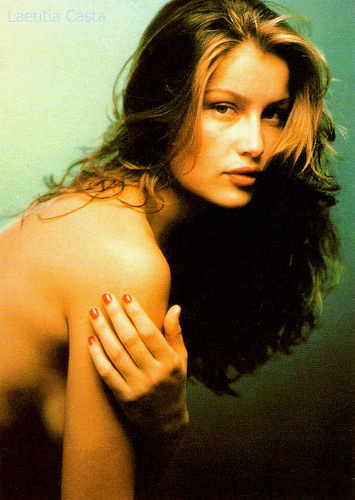
English postcard by GB Posters, Sheffield, no. PC 0144.
Marianne
Laetitia Marie Laure Casta was born in Pont-Audemer in Normandy in 1978. She spent her childhood in Normandy and Corsica, with her mother, Line Blin, from Normandy and her father, Dominique Casta, from Corsica. She has an older brother, Jean-Baptiste, and a younger sister, Marie-Ange.
Casta's modelling career reportedly began when she was discovered by the photographer Frederic Cresseaux, an agent of Paris' Madison Models, during a family holiday in her father's native Corsica, at age 15. With her natural beauty, she impressed both the agency's director and the editor of Elle magazine and got a contract.
In 1993 Laetitia signed on with Guess? Jeans for a very successful advertising campaign. Since 1998, Casta has been the L'Oréal Paris brand ambassador. Casta has appeared on over 100 magazine covers including Victoria's Secret catalogues, Harper's Bazaar, Elle magazine, and Vogue magazine. She is the face of several fragrances, including Chanel's Allure and Givenchy's Forbidden flower. She walked down the annual Victoria's Secret Fashion Show from 1997 till 2000.
In 1999, Casta was ranked first in a national survey ordered by the French Mayors Association to decide who should be the new model for the bust of Marianne, an allegorical symbol of the French Republic, which stands inside every French town hall.
For her first film, Casta has made forays into the blockbuster Asterix & Astérix et Obélix contre César/Asterix & Obelix Take On Caesar (Claude Zidi, 1999), based on the comic book by René Goscinny. In this live-action film, she played Falbala, a love interest for Obelix ( Gérard Depardieu ). It was the most expensive French film ever made and a smash hit in Europe.
Her acting career gained momentum when she starred in the TV mini-series La bicyclette bleue/The blue bicycle (Thierry Binisti, 2000), set in WWII France.
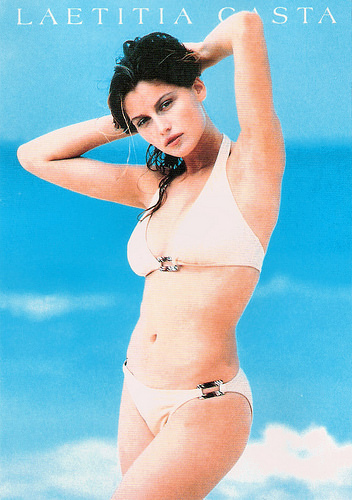
English postcard by Anabas, Essex, no. AP754.
Brigitte Bardot
In 2001, Laetitia Casta appeared in the dramatic film Les Âmes Fortes/Savage Souls (Raoul Ruiz, 2001). It was a major disappointment.
James Travers at Films de France : “Despite an impressive cast and some excellent production values, this quality adaptation of the classic French novel by Jean Giono generally fails to engage the spectator and is amongst the least satisfactory of Raoul Ruiz's directorial efforts to date. Visually impressive this film may be - with some beautiful photography of its Provencal setting and meticulous attention to period detail - but shallow characterization and uneven narrative pacing make watching it a painfully empty experience.”
Other films are Errance/Wandering (Damien Odoul, 2003) and the TV film Luisa Sanfelice (Paolo Taviani, Vittorio Taviani, 2004).
On stage she featured in the plays Ondine (2004-2005) written by Jean Giraudoux and Elle t'attend (She is waiting for you) (2008), written and directed by Florian Zeller.
In the cinema she worked with interesting directors like Olivier Ducastel and Jacques Martineau for Nés en 68/Born in 68 (2008) and Tsai Ming-Liang for Visage/Face (2009).
Her interpretation of Brigitte Bardot in the film Gainsbourg (Vie héroïque)/(Gainsbourg: A Heroic Life) (Joann Sfar, 2010) was received well. She was nominated for the César Award of the Best Supporting Actress.
Casta served as a jury member at the 69th Venice International Film Festival in 2012. That year, she also appeared in her first American film, Arbitrage (Nicholas Jarecki, 2012) starring Richard Gere.
In 2001, she gave birth to her daughter, Sahteene, by photographer Stéphane Sednaoui. Casta is now engaged to Italian actor Stefano Accorsi. The couple have two children, a son named Orlando (2006), and a daughter named Athenà (2009).
In 2012 Laetitia Casta became a Chevalier dans l'Ordre des Arts et des Lettres (Knight in Order of Arts and of Letters).
Later this year Casta can be seen with Vanessa Paradis and Isabelle Adjani in Very Bad Girls (Audrey Dana, 2014).
Trailer Gainsbourg (Vie héroïque)/(Gainsbourg: A Heroic Life) (2010). Source: icineytv (YouTube).
Sources: James Travers (Films de France), (IMDb), Wikipedia and .

English postcard by GB Posters, Sheffield, no. PC 0144.
Marianne
Laetitia Marie Laure Casta was born in Pont-Audemer in Normandy in 1978. She spent her childhood in Normandy and Corsica, with her mother, Line Blin, from Normandy and her father, Dominique Casta, from Corsica. She has an older brother, Jean-Baptiste, and a younger sister, Marie-Ange.
Casta's modelling career reportedly began when she was discovered by the photographer Frederic Cresseaux, an agent of Paris' Madison Models, during a family holiday in her father's native Corsica, at age 15. With her natural beauty, she impressed both the agency's director and the editor of Elle magazine and got a contract.
In 1993 Laetitia signed on with Guess? Jeans for a very successful advertising campaign. Since 1998, Casta has been the L'Oréal Paris brand ambassador. Casta has appeared on over 100 magazine covers including Victoria's Secret catalogues, Harper's Bazaar, Elle magazine, and Vogue magazine. She is the face of several fragrances, including Chanel's Allure and Givenchy's Forbidden flower. She walked down the annual Victoria's Secret Fashion Show from 1997 till 2000.
In 1999, Casta was ranked first in a national survey ordered by the French Mayors Association to decide who should be the new model for the bust of Marianne, an allegorical symbol of the French Republic, which stands inside every French town hall.
For her first film, Casta has made forays into the blockbuster Asterix & Astérix et Obélix contre César/Asterix & Obelix Take On Caesar (Claude Zidi, 1999), based on the comic book by René Goscinny. In this live-action film, she played Falbala, a love interest for Obelix ( Gérard Depardieu ). It was the most expensive French film ever made and a smash hit in Europe.
Her acting career gained momentum when she starred in the TV mini-series La bicyclette bleue/The blue bicycle (Thierry Binisti, 2000), set in WWII France.

English postcard by Anabas, Essex, no. AP754.
Brigitte Bardot
In 2001, Laetitia Casta appeared in the dramatic film Les Âmes Fortes/Savage Souls (Raoul Ruiz, 2001). It was a major disappointment.
James Travers at Films de France : “Despite an impressive cast and some excellent production values, this quality adaptation of the classic French novel by Jean Giono generally fails to engage the spectator and is amongst the least satisfactory of Raoul Ruiz's directorial efforts to date. Visually impressive this film may be - with some beautiful photography of its Provencal setting and meticulous attention to period detail - but shallow characterization and uneven narrative pacing make watching it a painfully empty experience.”
Other films are Errance/Wandering (Damien Odoul, 2003) and the TV film Luisa Sanfelice (Paolo Taviani, Vittorio Taviani, 2004).
On stage she featured in the plays Ondine (2004-2005) written by Jean Giraudoux and Elle t'attend (She is waiting for you) (2008), written and directed by Florian Zeller.
In the cinema she worked with interesting directors like Olivier Ducastel and Jacques Martineau for Nés en 68/Born in 68 (2008) and Tsai Ming-Liang for Visage/Face (2009).
Her interpretation of Brigitte Bardot in the film Gainsbourg (Vie héroïque)/(Gainsbourg: A Heroic Life) (Joann Sfar, 2010) was received well. She was nominated for the César Award of the Best Supporting Actress.
Casta served as a jury member at the 69th Venice International Film Festival in 2012. That year, she also appeared in her first American film, Arbitrage (Nicholas Jarecki, 2012) starring Richard Gere.
In 2001, she gave birth to her daughter, Sahteene, by photographer Stéphane Sednaoui. Casta is now engaged to Italian actor Stefano Accorsi. The couple have two children, a son named Orlando (2006), and a daughter named Athenà (2009).
In 2012 Laetitia Casta became a Chevalier dans l'Ordre des Arts et des Lettres (Knight in Order of Arts and of Letters).
Later this year Casta can be seen with Vanessa Paradis and Isabelle Adjani in Very Bad Girls (Audrey Dana, 2014).
Trailer Gainsbourg (Vie héroïque)/(Gainsbourg: A Heroic Life) (2010). Source: icineytv (YouTube).
Sources: James Travers (Films de France), (IMDb), Wikipedia and .
Published on August 03, 2014 23:00
August 2, 2014
Siegfried Breuer jr.
Siegfried Breuer jr. (1930-2004) was an Austrian film actor. He often played the dashing young lover in German films of the 1950s and early 1960s.
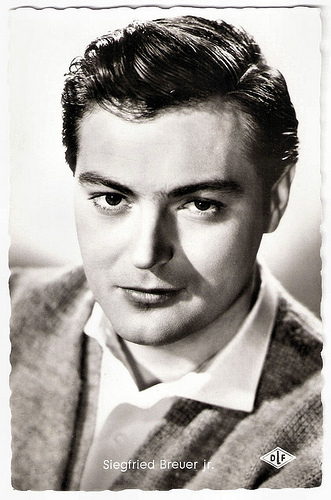
German postcard by Kolibri-Verlag, Minden-Westf., no. 1961. Photo: Deutsche London / Von Mindszenty. Publicity still for Die gestolene Hose/The stolen Trousers (Géza von Cziffra, 1956).
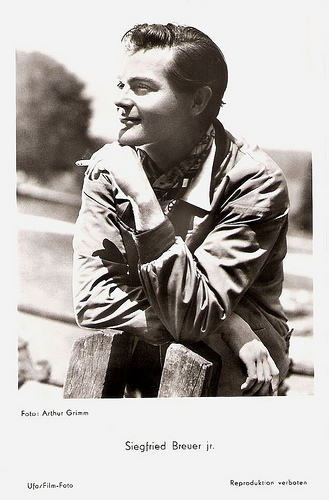
German postcard by Ufa, Berlin-Tempelhof, no. FK 2058. Photo: Arthur Grimm.
A Sweet and Handsome Jeune Premier
Siegfried Breuer jr. was born as Walter Breuer in Vienna, Austria in 1930.
He was the son of the actor Siegfried Breuer, who had been a famous film actor during the Third Reich.
Walter was trained at the Max Reinhardt Seminar in Vienna, and since 1952 he worked as a film actor.
In 1954, after his father had died, the 23 years old was promoted as the new star, Siegfried Breuer jr. His first major role was in Der Schweigende Engel/The Silent Angel (Harald Reinl, 1954) starring Christine Kaufmann .
In contrast to his father Siegfried, who often embodied the icy seducer, junior was primarily cast in light entertainment films as a sweet and handsome jeune premier (the youthful lover).
He was seen as such on the side of the young Romy Schneider in Die Deutschmeister/A March for the Emperor (Ernst Marischka, 1955), Margit Saad in Drei Mädels vom Rhein/Three girls from the Rhine (Georg Jacoby, 1955) and Susanne Cramer in Die gestolene Hose/The stolen Trousers (Géza von Cziffra, 1956).
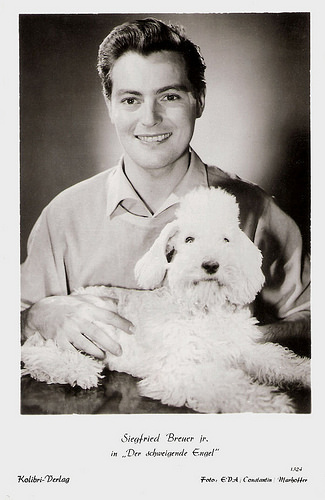
German postcard by Kolibri-Verlag, no. 1324. Photo: EVA / Constantin / Marhoffer. Publicity still for Der Schweigende Engel/The Silent Angel (Harald Reinl, 1954).
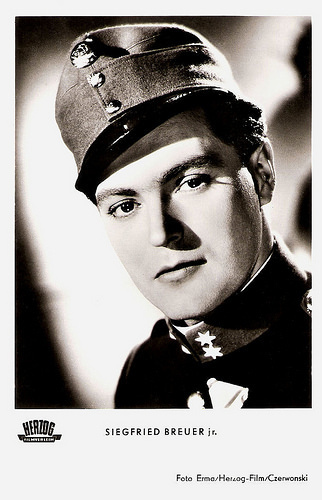
German postcard by Kunst und Bild, no. V 318. Photo: Erma / Herzog-Film / Czerwonski. Publicity still for Der Deutschmeister/A March for the Emperor (Ernst Marischka, 1955).
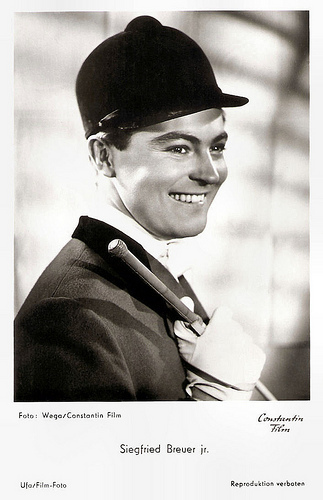
German postcard by Ufa, Berlin-Tempelhof, no. FK 1692. Photo: Wega / Constantin.
Tinny Voice
By his own assessment, Siegfried Breuer jr. was miscast as the charming lover with his ‘tinny voice’ and broadcast feature, which was anything but gracious. After five years, he changed his name back to Walter Breuer.
He played smaller roles in films like the drama Polikuschka/Polikuska (Carmine Gallone, 1958) featuring Folco Lulli, and the Yugoslavian war film Kapetan Lesi/Captain Lechi (Zivorad 'Zika' Mitrovic, 1960).
One of his final films was In Frankfurt sind die Nächte heiß/In Frankfurt, the nights are hot (Rolf Olsen, 1966) with Vera Tschechowa .
After his film career, he worked at the Bayerischer Rundfunk as a production assistant.
In 2004, Walter Breuer passed away. He was 73. According to an obituary in the German newspaper Die Welt, the burden to be a son of a famous father had been heavy for him.
However, his sons Jacques and Pascal Breuer have also become actors.
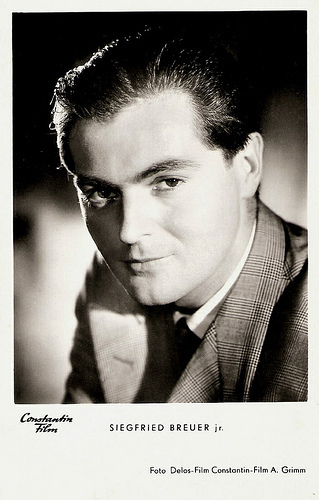
German postcard by Kunst und Bild, Berlin, no. T 642. Photo: A. Grimm / Delos / Constantin. Publicity still for Roman einer Siebzehnjährigen/Novel of a seventeen year old (Paul Verhoeven, 1955).
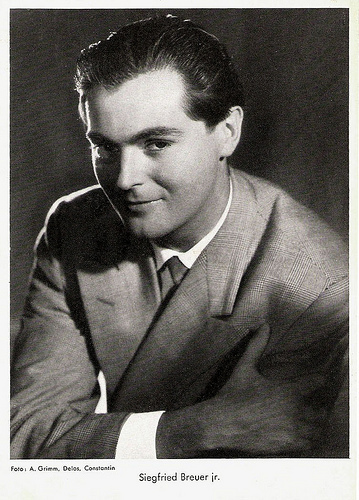
German card. Photo: A. Grimm / Delos / Constantin.
Sources: Die Welt (German), Wikipedia (German), and .

German postcard by Kolibri-Verlag, Minden-Westf., no. 1961. Photo: Deutsche London / Von Mindszenty. Publicity still for Die gestolene Hose/The stolen Trousers (Géza von Cziffra, 1956).

German postcard by Ufa, Berlin-Tempelhof, no. FK 2058. Photo: Arthur Grimm.
A Sweet and Handsome Jeune Premier
Siegfried Breuer jr. was born as Walter Breuer in Vienna, Austria in 1930.
He was the son of the actor Siegfried Breuer, who had been a famous film actor during the Third Reich.
Walter was trained at the Max Reinhardt Seminar in Vienna, and since 1952 he worked as a film actor.
In 1954, after his father had died, the 23 years old was promoted as the new star, Siegfried Breuer jr. His first major role was in Der Schweigende Engel/The Silent Angel (Harald Reinl, 1954) starring Christine Kaufmann .
In contrast to his father Siegfried, who often embodied the icy seducer, junior was primarily cast in light entertainment films as a sweet and handsome jeune premier (the youthful lover).
He was seen as such on the side of the young Romy Schneider in Die Deutschmeister/A March for the Emperor (Ernst Marischka, 1955), Margit Saad in Drei Mädels vom Rhein/Three girls from the Rhine (Georg Jacoby, 1955) and Susanne Cramer in Die gestolene Hose/The stolen Trousers (Géza von Cziffra, 1956).

German postcard by Kolibri-Verlag, no. 1324. Photo: EVA / Constantin / Marhoffer. Publicity still for Der Schweigende Engel/The Silent Angel (Harald Reinl, 1954).

German postcard by Kunst und Bild, no. V 318. Photo: Erma / Herzog-Film / Czerwonski. Publicity still for Der Deutschmeister/A March for the Emperor (Ernst Marischka, 1955).

German postcard by Ufa, Berlin-Tempelhof, no. FK 1692. Photo: Wega / Constantin.
Tinny Voice
By his own assessment, Siegfried Breuer jr. was miscast as the charming lover with his ‘tinny voice’ and broadcast feature, which was anything but gracious. After five years, he changed his name back to Walter Breuer.
He played smaller roles in films like the drama Polikuschka/Polikuska (Carmine Gallone, 1958) featuring Folco Lulli, and the Yugoslavian war film Kapetan Lesi/Captain Lechi (Zivorad 'Zika' Mitrovic, 1960).
One of his final films was In Frankfurt sind die Nächte heiß/In Frankfurt, the nights are hot (Rolf Olsen, 1966) with Vera Tschechowa .
After his film career, he worked at the Bayerischer Rundfunk as a production assistant.
In 2004, Walter Breuer passed away. He was 73. According to an obituary in the German newspaper Die Welt, the burden to be a son of a famous father had been heavy for him.
However, his sons Jacques and Pascal Breuer have also become actors.

German postcard by Kunst und Bild, Berlin, no. T 642. Photo: A. Grimm / Delos / Constantin. Publicity still for Roman einer Siebzehnjährigen/Novel of a seventeen year old (Paul Verhoeven, 1955).

German card. Photo: A. Grimm / Delos / Constantin.
Sources: Die Welt (German), Wikipedia (German), and .
Published on August 02, 2014 23:00
August 1, 2014
Giulietta Masina
Italian film and stage actress Giulietta Masina (1921-1994) starred in the classics La strada (1954) and Notti di Cabiria (1957), both directed by her husband Federico Fellini and both winners of the Oscar for Best Foreign Language Film. The only 1,57 m long Masina was often called the ‘female Chaplin’. The skilled, button-eyed comedienne could deliver intense dramatic performances of naive characters dealing with cruel circumstances.
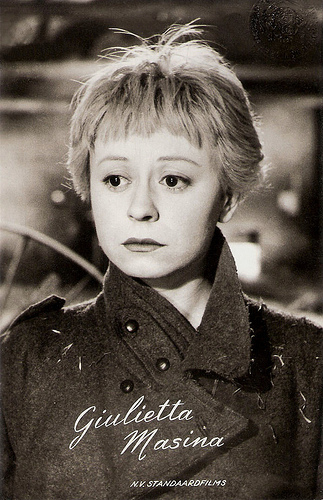
Dutch postcard by Uitg. Takken, Utrecht, no. 3381. Photo: N.V. Standaardfilms. Publicity still for La strada (1954).
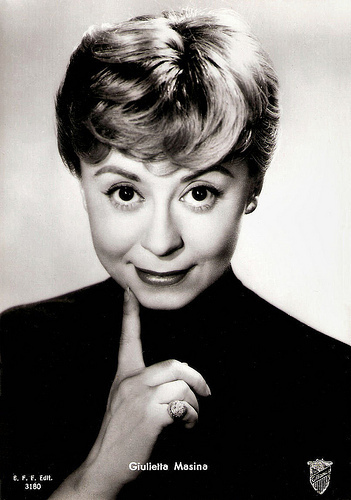
Italian postcard by Casa Edite. Ballerini & Fratini, Firenze (Florence), no. 3180. Photo: Titanus. Publicity still for Il Bidone (1955).
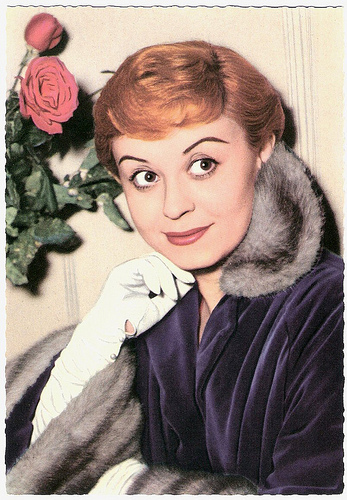
German postcard by ISV, no. D 15. Photo: ISV.
Federichino
Giulia Anna Masina was born in San Giorgio di Piano near Bologna in 1921. Her parents were Gaetano Masina, a violinist and a music teacher, and Anna Flavia Pasqualin, a schoolteacher. She had three elder siblings: Eugenia, and twins Mario and Maria.
Giulietta spent most of her teenage years in Rome at the home of a widowed aunt, where she cultivated a passion for the theatre. She attended the Hermanas Ursulinas school, and graduated in Literature from the Sapienza University of Rome.
At university, she turned to acting. From 1941 on, she participated in numerous plays that included singing and dancing as well as acting, all in the Ateneo Theater of her university.
In 1942, she joined the Compagnia del Teatro Comico Musicale and played various roles on stage. After seeing her photographs, she was cast by Federico Fellini, who was writing the radio serial Terziglio about a the adventures of the newlyweds Cico and Pallina.
Masina and Fellini fell in love while working on the successful program and were married in 1943. Several months after her marriage to Fellini, in 1943, Masina suffered a miscarriage after falling down a flight of stairs. She became pregnant again; Pierfederico (nicknamed Federichino) was born on 22 March 1945, but died just a month later on 24 April owing to respiratory insufficiency. Masina and Fellini did not have another child.
Despite distancing herself from live theatre, Masina did return to the university stage for some time acting with Marcello Mastroianni . Her last stage appearance was in 1951.
Working together with her husband, Masina made the transition to on-screen acting. Half of her Italian films, the most successful ones, would be either written or directed by her husband.
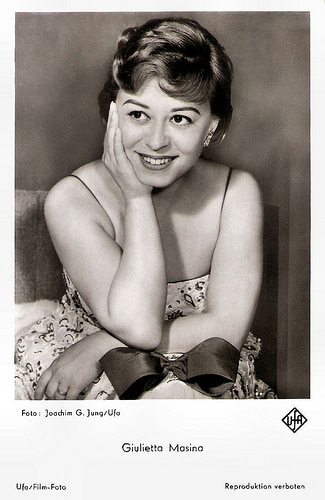
German postcard by Ufa, Berlin-Tempelhof, no. FK 4154. Photo: Joachim G. Jung / Ufa.
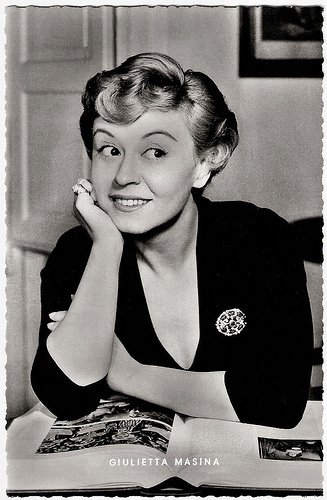
German postcard by Kunst und Bild, Berlin-Charlottenburg, no. V 169. Photo: Unitalia Film / Luxardo / Alessi.
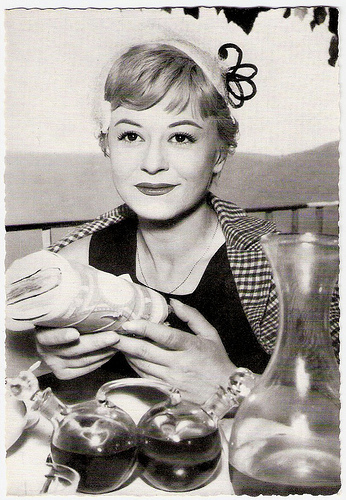
German postcard vy WS-Druck, Wanne-Eickel, no. 236. Photo: Filmpress Zürich.
Cabiria and Gelsomina
Giulietta Masina made her film debut in an uncredited role in the neo-realist war drama Paisà/Paisan (Roberto Rossellini, 1946), co-written by Fellini.
She received her first screen credit in the crime drama Senza pièta/Without Pity (Alberto Lattuada, 1948) starring Carla del Poggio , which was another adaptation by Fellini. Masina’s performance earned her a Silver Ribbon, Italy's most prominent motion-picture award, as Best Supporting Actress.
She then co-starred in Fellini’s début as a director, Luci del varietà/Variety Lights (Federico Fellini, Alberto Lattuado, 1950) with Peppino di Filippo and Carla del Poggio . It is a bittersweet drama about a bunch of misfits in a traveling vaudeville troupe.
A box office hit was the prostitution drama Persiane chiuse/Behind Closed Shutters (Luigi Comencini, 1951) with Massimo Girotti and Eleonora Rossi Drago . She had a supporting part in Europa '51/The Greatest Love (Roberto Rossellini, 1952) starring Ingrid Bergman .
She also appeared in the second film of her husband, the hilarious comedy Lo sceicco bianco/The White Sheik (Federico Fellini, 1952) featuring Alberto Sordi.
At AllMovie , Hal Erickson adds: “Featured in the cast is Fellini's wife Giuletta Masina as a prostitute named Cabiria, who'd be given a vehicle of her own, Nights of Cabiria, in 1955 (sic). Based on ‘an idea’ by Michelangelo Antonioni, The White Sheik was the main inspiration for Gene Wilder's The World's Greatest Lover (1977).”
After some lesser films by other directors she finally had her international breakthrough in Fellini's La strada/The Road (Federico Fellini, 1954), as the young Gelsomina, who is sold to the violent traveling strongman Zampano (Anthony Quinn) by her poor mother.
At IMDb , Matt Whittle writes: “Giulietta Masina is the highlight of the film. With a face like no other, it exudes a certain beauty but is also very odd, with a definite quirkiness to it.”
She was also co-starring in Fellini’s next, lesser known effort Il Bidone/The Swindle (Federico Fellini, 1955) with Broderick Crawford, Richard Basehart, and Franco Fabrizi as a trio of con artists who victimize the Italian bourgeoisie (who are shown to be no better than the crooks). Masina played Basehart’s wife.
In 1957, she won the Best Actress Award at the Cannes Film Festival for her portrayal of the title role in Fellini's widely acclaimed Le notti di Cabiria/Nights of Cabiria (Federico Fellini, 1957). She played the innocent prostitute Cabiria who was born to lose - but still never would give up.
In 1956 and in 1957 Fellini and Masina were awarded the Academy Award for Best Foreign Film, for La Strada and for Le notti di Cabiria.
In the following years Masina appeared in several films by other directors, including the prison drama Nella città l'inferno/...and the Wild Wild Women (Renato Castellani, 1959) with Anna Magnani and the German-Italian production Jons und Erdme/Jons and Erdme (Victor Vicas, 1959) opposite Carl Raddatz .
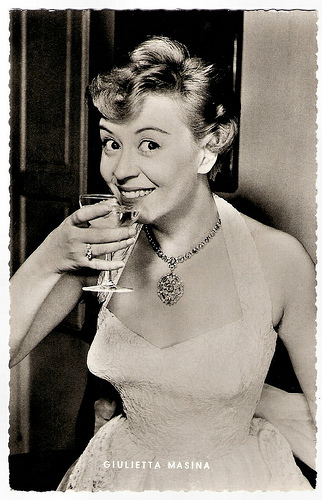
German postcard by Kunst und Bild, Berlin-Charlottenburg, no. S 772. Photo: Unitalia Film / Luxardo / Alessi.
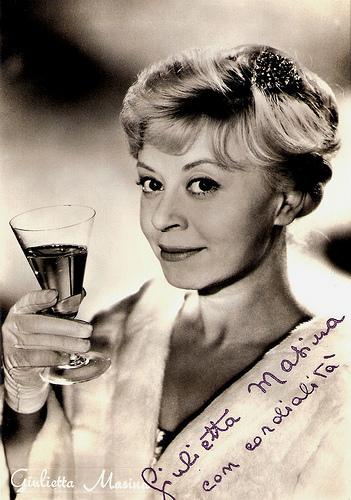
Italian postcard by Rotalfoto, Milano, no. 907.
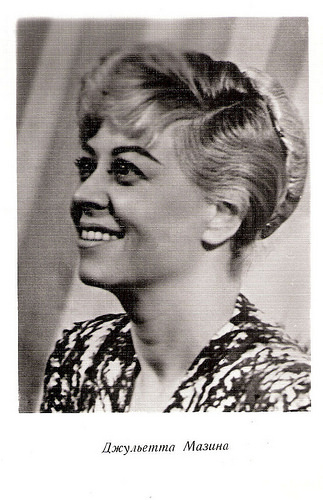
Russian postcard.
Ginger
In 1960, Giulietta Masina's career was damaged by the critical and box office failure of the massive international production Das kunstseidene Mädchen/The High Life (Julien Duvivier, 1960) with Gustav Knuth and Gert Fröbe.
Subsequently, she became dedicated almost entirely to her personal life and marriage. Nonetheless, she again worked with her husband in Giulietta degli spiriti/Juliet of the Spirits (Federico Fellini, 1965), which earned both the New York Film Critics award (1965) and the Golden Globe award (1966) for Best Foreign Language Film.
In 1969, Masina did her first work in English in The Madwoman of Chaillot (Bryan Forbes, 1969) which starred Katharine Hepburn.
From 1966 till 1969, Masina hosted a popular radio show, Lettere aperte a Giulietta Masina, in which she addressed correspondence from her listeners. The letters were eventually published in a book.
From the 1970s on, she appeared on television. Two performances, in Eleonora (Silverio Blasi, 1973) and Camilla (Sandro Bolchi, 1976), respectively, were particularly acclaimed.
After almost two decades, Masina appeared in Fellini's Ginger e Fred/Ginger and Fred (Federico Fellini, 1986).
Hal Erickson at AllMovie : “Fellini gently lampoons the world of small-time show business (...) Masina and Marcello Mastroianni star as Amelia Bonetti and Pippo Botticella, a onetime celebrity song-and-dance team. Having risen to fame with a dancing act where they recreated the acts of Ginger Rogers and Fred Astaire (hoping to become the Fred and Ginger of Italy), Amelia and Pippo parted company to pursue their separate lives. Neither one was particularly successful in other fields of endeavor, so when after many years Amelia is offered a guest-star gig on a TV variety show, she jumps at the chance. (...) The overall good cheer of the film was dampened when the real Ginger Rogers sued the distributors of Ginger and Fred for ‘defamation of character’.”
Masina then rejected outside offers in order to attend to her husband's precarious health. Her last film was Aujourd'hui peut-être/A Day to Remember (Jean-Louis Bertucelli, 1991).
Giulietta Masina died from lung cancer in 1994, aged 73, less than five months after her husband's demise. They are buried together at Rimini cemetery in a tomb marked by a prow-shaped monument, the work of sculptor Arnaldo Pomodoro.
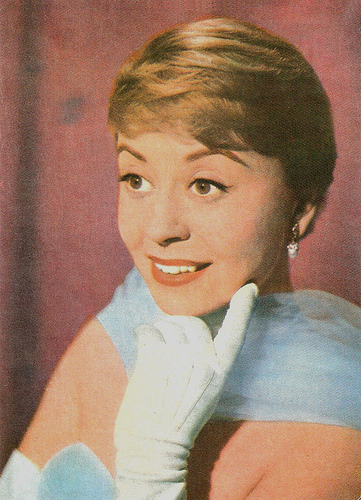
Romanian postcard by Casa Filmului Acin.
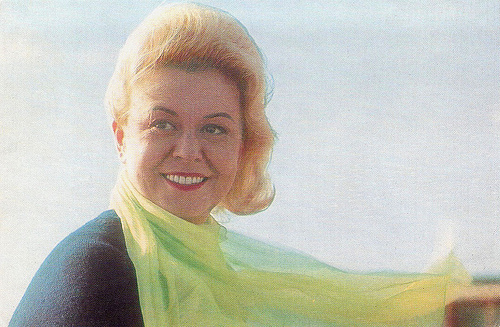
Russian postcard by Izdanije Byuro Propogandy Sovietskogo Kinoiskusstva, no. 109/75, 1975. This postcard was printed in an edition of 200.000 cards. The price was 5 kop.
Trailer of La strada/The Road (1954). Source: RevistaTOMIS (YouTube).
Sources: Matt Whittle (IMDb), Jason Ankeny (AllMovie), Hal Erickson (AllMovie), F.T. (Italica), Wikipedia, and .

Dutch postcard by Uitg. Takken, Utrecht, no. 3381. Photo: N.V. Standaardfilms. Publicity still for La strada (1954).

Italian postcard by Casa Edite. Ballerini & Fratini, Firenze (Florence), no. 3180. Photo: Titanus. Publicity still for Il Bidone (1955).

German postcard by ISV, no. D 15. Photo: ISV.
Federichino
Giulia Anna Masina was born in San Giorgio di Piano near Bologna in 1921. Her parents were Gaetano Masina, a violinist and a music teacher, and Anna Flavia Pasqualin, a schoolteacher. She had three elder siblings: Eugenia, and twins Mario and Maria.
Giulietta spent most of her teenage years in Rome at the home of a widowed aunt, where she cultivated a passion for the theatre. She attended the Hermanas Ursulinas school, and graduated in Literature from the Sapienza University of Rome.
At university, she turned to acting. From 1941 on, she participated in numerous plays that included singing and dancing as well as acting, all in the Ateneo Theater of her university.
In 1942, she joined the Compagnia del Teatro Comico Musicale and played various roles on stage. After seeing her photographs, she was cast by Federico Fellini, who was writing the radio serial Terziglio about a the adventures of the newlyweds Cico and Pallina.
Masina and Fellini fell in love while working on the successful program and were married in 1943. Several months after her marriage to Fellini, in 1943, Masina suffered a miscarriage after falling down a flight of stairs. She became pregnant again; Pierfederico (nicknamed Federichino) was born on 22 March 1945, but died just a month later on 24 April owing to respiratory insufficiency. Masina and Fellini did not have another child.
Despite distancing herself from live theatre, Masina did return to the university stage for some time acting with Marcello Mastroianni . Her last stage appearance was in 1951.
Working together with her husband, Masina made the transition to on-screen acting. Half of her Italian films, the most successful ones, would be either written or directed by her husband.

German postcard by Ufa, Berlin-Tempelhof, no. FK 4154. Photo: Joachim G. Jung / Ufa.

German postcard by Kunst und Bild, Berlin-Charlottenburg, no. V 169. Photo: Unitalia Film / Luxardo / Alessi.

German postcard vy WS-Druck, Wanne-Eickel, no. 236. Photo: Filmpress Zürich.
Cabiria and Gelsomina
Giulietta Masina made her film debut in an uncredited role in the neo-realist war drama Paisà/Paisan (Roberto Rossellini, 1946), co-written by Fellini.
She received her first screen credit in the crime drama Senza pièta/Without Pity (Alberto Lattuada, 1948) starring Carla del Poggio , which was another adaptation by Fellini. Masina’s performance earned her a Silver Ribbon, Italy's most prominent motion-picture award, as Best Supporting Actress.
She then co-starred in Fellini’s début as a director, Luci del varietà/Variety Lights (Federico Fellini, Alberto Lattuado, 1950) with Peppino di Filippo and Carla del Poggio . It is a bittersweet drama about a bunch of misfits in a traveling vaudeville troupe.
A box office hit was the prostitution drama Persiane chiuse/Behind Closed Shutters (Luigi Comencini, 1951) with Massimo Girotti and Eleonora Rossi Drago . She had a supporting part in Europa '51/The Greatest Love (Roberto Rossellini, 1952) starring Ingrid Bergman .
She also appeared in the second film of her husband, the hilarious comedy Lo sceicco bianco/The White Sheik (Federico Fellini, 1952) featuring Alberto Sordi.
At AllMovie , Hal Erickson adds: “Featured in the cast is Fellini's wife Giuletta Masina as a prostitute named Cabiria, who'd be given a vehicle of her own, Nights of Cabiria, in 1955 (sic). Based on ‘an idea’ by Michelangelo Antonioni, The White Sheik was the main inspiration for Gene Wilder's The World's Greatest Lover (1977).”
After some lesser films by other directors she finally had her international breakthrough in Fellini's La strada/The Road (Federico Fellini, 1954), as the young Gelsomina, who is sold to the violent traveling strongman Zampano (Anthony Quinn) by her poor mother.
At IMDb , Matt Whittle writes: “Giulietta Masina is the highlight of the film. With a face like no other, it exudes a certain beauty but is also very odd, with a definite quirkiness to it.”
She was also co-starring in Fellini’s next, lesser known effort Il Bidone/The Swindle (Federico Fellini, 1955) with Broderick Crawford, Richard Basehart, and Franco Fabrizi as a trio of con artists who victimize the Italian bourgeoisie (who are shown to be no better than the crooks). Masina played Basehart’s wife.
In 1957, she won the Best Actress Award at the Cannes Film Festival for her portrayal of the title role in Fellini's widely acclaimed Le notti di Cabiria/Nights of Cabiria (Federico Fellini, 1957). She played the innocent prostitute Cabiria who was born to lose - but still never would give up.
In 1956 and in 1957 Fellini and Masina were awarded the Academy Award for Best Foreign Film, for La Strada and for Le notti di Cabiria.
In the following years Masina appeared in several films by other directors, including the prison drama Nella città l'inferno/...and the Wild Wild Women (Renato Castellani, 1959) with Anna Magnani and the German-Italian production Jons und Erdme/Jons and Erdme (Victor Vicas, 1959) opposite Carl Raddatz .

German postcard by Kunst und Bild, Berlin-Charlottenburg, no. S 772. Photo: Unitalia Film / Luxardo / Alessi.

Italian postcard by Rotalfoto, Milano, no. 907.

Russian postcard.
Ginger
In 1960, Giulietta Masina's career was damaged by the critical and box office failure of the massive international production Das kunstseidene Mädchen/The High Life (Julien Duvivier, 1960) with Gustav Knuth and Gert Fröbe.
Subsequently, she became dedicated almost entirely to her personal life and marriage. Nonetheless, she again worked with her husband in Giulietta degli spiriti/Juliet of the Spirits (Federico Fellini, 1965), which earned both the New York Film Critics award (1965) and the Golden Globe award (1966) for Best Foreign Language Film.
In 1969, Masina did her first work in English in The Madwoman of Chaillot (Bryan Forbes, 1969) which starred Katharine Hepburn.
From 1966 till 1969, Masina hosted a popular radio show, Lettere aperte a Giulietta Masina, in which she addressed correspondence from her listeners. The letters were eventually published in a book.
From the 1970s on, she appeared on television. Two performances, in Eleonora (Silverio Blasi, 1973) and Camilla (Sandro Bolchi, 1976), respectively, were particularly acclaimed.
After almost two decades, Masina appeared in Fellini's Ginger e Fred/Ginger and Fred (Federico Fellini, 1986).
Hal Erickson at AllMovie : “Fellini gently lampoons the world of small-time show business (...) Masina and Marcello Mastroianni star as Amelia Bonetti and Pippo Botticella, a onetime celebrity song-and-dance team. Having risen to fame with a dancing act where they recreated the acts of Ginger Rogers and Fred Astaire (hoping to become the Fred and Ginger of Italy), Amelia and Pippo parted company to pursue their separate lives. Neither one was particularly successful in other fields of endeavor, so when after many years Amelia is offered a guest-star gig on a TV variety show, she jumps at the chance. (...) The overall good cheer of the film was dampened when the real Ginger Rogers sued the distributors of Ginger and Fred for ‘defamation of character’.”
Masina then rejected outside offers in order to attend to her husband's precarious health. Her last film was Aujourd'hui peut-être/A Day to Remember (Jean-Louis Bertucelli, 1991).
Giulietta Masina died from lung cancer in 1994, aged 73, less than five months after her husband's demise. They are buried together at Rimini cemetery in a tomb marked by a prow-shaped monument, the work of sculptor Arnaldo Pomodoro.

Romanian postcard by Casa Filmului Acin.

Russian postcard by Izdanije Byuro Propogandy Sovietskogo Kinoiskusstva, no. 109/75, 1975. This postcard was printed in an edition of 200.000 cards. The price was 5 kop.
Trailer of La strada/The Road (1954). Source: RevistaTOMIS (YouTube).
Sources: Matt Whittle (IMDb), Jason Ankeny (AllMovie), Hal Erickson (AllMovie), F.T. (Italica), Wikipedia, and .
Published on August 01, 2014 23:00
July 31, 2014
Jean Mounet-Sully
Mounet-Sully (1841-1916) was one of the greatest French theatre actors of the late 19th and early 20th century. He appeared in several short silent films of the Film d'art cinema.
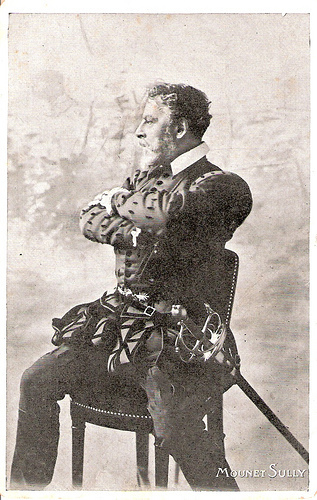
French postcard.
Striking presence, voice and vigorous acting
Mounet-Sully was born as Jean-Sully Mounet in Bergerac in the Dordogne, France in 1841.
He had his dramatic training at the Conservatoire in Paris, which he entered at the age of twenty-one. At the Conservatoire he took the first prize for tragedy.
He made his stage debut at the Odeon theatre in 1868, without attracting much attention.
His career was interrupted by the Franco-Prussian War of 1870-1871, and his passion for his military career almost convinced him to give up the stage career.
In 1872 he had his breakthrough, when he could play Oreste in Jean Racine's Andromaqueat the Comédie-Française.
In the following years is striking presence, voice and vigorous acting made him one of the most important actors of the Comédie-Française. He played the great roles of the classic repertory, including Achilles in Racine's Iphigenie et Aulide, Rodrigue in Le Cid, Nero in Brittanicus, Hippolyte in Phèdre and the title parts in Victor Hugo's Hernani and Ruy Blas.
He reached his apex in 1881 with the première of L'Oedipe roi, a French version by Jules Lacroix of Sophocles' drama Oedipus Rex.
Mounet-Sully was innovating in thinking that an actor should lose his own personality and totally absorb that of his character, once on stage.
His Oedipus was such a performance that only until 1937, when Jean Cocteau's La Machine Infernale really revived Sophocles' play in a modernised version at the Theatre Antoine. It was also the adebut for actor Jean Marais .
Another triumph for Mounet-Sully was his Hamlet in the play by William Shakespeare in 1886. He was created chevalier of the Legion of Honour in 1889.
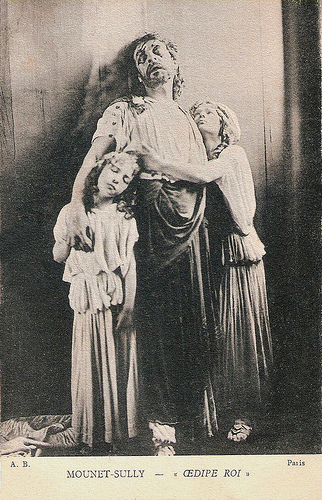
French postcard by A.B. Photo: still of Mounet-Sully in the play Oedipe Roi/Oedipus Rex by Sophocles.
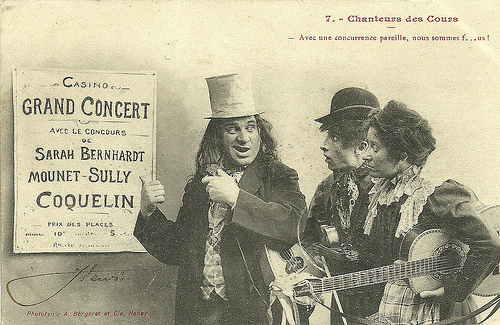
French postcard in the series Chanteurs des Cours, no. 7. Photo: A. Bergeret & Co., Nancy. Caption: "Avec une concurrence pareille, nous sommes f....us!" (With such a competition, we are lost!)
This postcard is from a caricature series on street singers. The names on the poster refer to well acclaimed actors around 1900: Sarah Bernhardt , Mounet-Sully and Jean Coquelin .
Film d'Art Cinema
Mounet-Sully also was a film actor during the short French 'wave' of the film d'art cinema.
In 1908 he acted in a film after his stage success Oedipe roi, directed by André Calmettes.
Soon other examples of his previous popular stage performances were transformed into film: Brittanicus (André Calmettes, 1908) opposite Gabrielle Réjane and Hamlet (Gerard Bourgeois, 1908).
In 1913 Mounet-Sully acted in another adaptation of Sophocles' play, entitled La légende d'Oedipe, and directed by Gaston Roudès. In this film also played his younger brother Paul Mounet and Joë Hamman .
When the First World War broke out and many actors were mobilised, he defended the interests of his Comédie-Française, where he had been a Doyen (dean) since 1894.
Although he was over seventy years old, he still played at the Comédie-Française from time to time. In 1915 he played here his last role, his former success Polyeucte.
Mounet-Sully died in 1916 in Paris. He was 75.
He was married to actress Jeanne Remy. Their daughter was the actress Jeanne Sully.
He was a good friend, co-performer, and one-time lover of legendary actress Sarah Bernhardt .
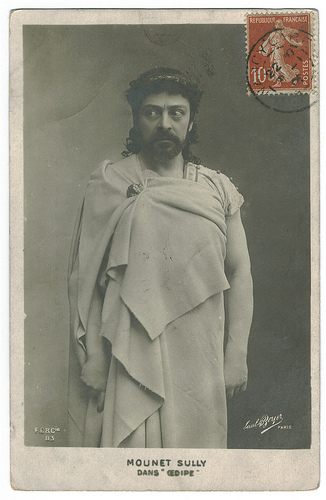
French postcard by FC & C, no. 83. Photo Saul Boyer. Collection: Manuel Palomino Arjona.
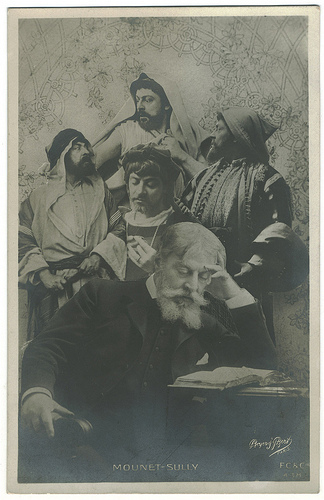
French postcard by FC & C, no. 438. Photo Saul Boyer. Collection: Manuel Palomino Arjona.
Sources: Encyclopædia Britannica, Wikipedia (French and English) and .

French postcard.
Striking presence, voice and vigorous acting
Mounet-Sully was born as Jean-Sully Mounet in Bergerac in the Dordogne, France in 1841.
He had his dramatic training at the Conservatoire in Paris, which he entered at the age of twenty-one. At the Conservatoire he took the first prize for tragedy.
He made his stage debut at the Odeon theatre in 1868, without attracting much attention.
His career was interrupted by the Franco-Prussian War of 1870-1871, and his passion for his military career almost convinced him to give up the stage career.
In 1872 he had his breakthrough, when he could play Oreste in Jean Racine's Andromaqueat the Comédie-Française.
In the following years is striking presence, voice and vigorous acting made him one of the most important actors of the Comédie-Française. He played the great roles of the classic repertory, including Achilles in Racine's Iphigenie et Aulide, Rodrigue in Le Cid, Nero in Brittanicus, Hippolyte in Phèdre and the title parts in Victor Hugo's Hernani and Ruy Blas.
He reached his apex in 1881 with the première of L'Oedipe roi, a French version by Jules Lacroix of Sophocles' drama Oedipus Rex.
Mounet-Sully was innovating in thinking that an actor should lose his own personality and totally absorb that of his character, once on stage.
His Oedipus was such a performance that only until 1937, when Jean Cocteau's La Machine Infernale really revived Sophocles' play in a modernised version at the Theatre Antoine. It was also the adebut for actor Jean Marais .
Another triumph for Mounet-Sully was his Hamlet in the play by William Shakespeare in 1886. He was created chevalier of the Legion of Honour in 1889.

French postcard by A.B. Photo: still of Mounet-Sully in the play Oedipe Roi/Oedipus Rex by Sophocles.

French postcard in the series Chanteurs des Cours, no. 7. Photo: A. Bergeret & Co., Nancy. Caption: "Avec une concurrence pareille, nous sommes f....us!" (With such a competition, we are lost!)
This postcard is from a caricature series on street singers. The names on the poster refer to well acclaimed actors around 1900: Sarah Bernhardt , Mounet-Sully and Jean Coquelin .
Film d'Art Cinema
Mounet-Sully also was a film actor during the short French 'wave' of the film d'art cinema.
In 1908 he acted in a film after his stage success Oedipe roi, directed by André Calmettes.
Soon other examples of his previous popular stage performances were transformed into film: Brittanicus (André Calmettes, 1908) opposite Gabrielle Réjane and Hamlet (Gerard Bourgeois, 1908).
In 1913 Mounet-Sully acted in another adaptation of Sophocles' play, entitled La légende d'Oedipe, and directed by Gaston Roudès. In this film also played his younger brother Paul Mounet and Joë Hamman .
When the First World War broke out and many actors were mobilised, he defended the interests of his Comédie-Française, where he had been a Doyen (dean) since 1894.
Although he was over seventy years old, he still played at the Comédie-Française from time to time. In 1915 he played here his last role, his former success Polyeucte.
Mounet-Sully died in 1916 in Paris. He was 75.
He was married to actress Jeanne Remy. Their daughter was the actress Jeanne Sully.
He was a good friend, co-performer, and one-time lover of legendary actress Sarah Bernhardt .

French postcard by FC & C, no. 83. Photo Saul Boyer. Collection: Manuel Palomino Arjona.

French postcard by FC & C, no. 438. Photo Saul Boyer. Collection: Manuel Palomino Arjona.
Sources: Encyclopædia Britannica, Wikipedia (French and English) and .
Published on July 31, 2014 23:00
July 30, 2014
Tala Birell
Austrian actress Tala Birell (1907–1958) was a protégé of legendary stage director Max Reinhardt and became popular in his Viennese productions. Universal signed her to star in Hollywood films and the studio built her up as a new Garbo. To no avail. During the 1940s and early 1950s she mainly worked in B-films and for TV.
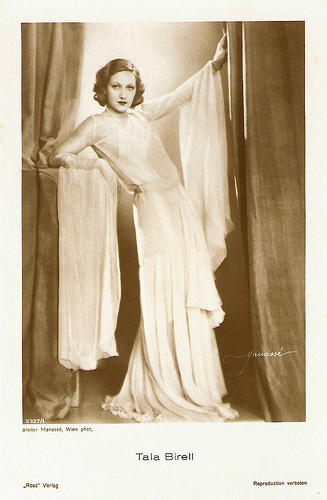
German postcard by Ross Verlag, Berlin, no. 5327/1, 1930-1931. Photo: Manassé , Wien.
Max Reinhardt
Tall and blond Tala Birell was born as Natalie Bierl in Bucharest, Romania in 1907. Her mother Stephanie Sahaydakowska, was a Polish baroness, and her father, Carl Bierl, an Austrian businessman. They were temporarily in Bucharest while he was overseeing his company there.
Nathale and her three sisters and one brother enjoyed an idyllic life, summering at the Polish estate of her aristocratic uncle. During WWI the family was in Berlin, where Nathalie studied at a private school. After the war her father died and her privileged childhood came to an end.
She dreamed of the theatre, and made her stage debut in Berlin in 1926 in The Mikado with Erik Charell.
That year, she also made her film debut credited as Thala Birell in a bit role in Man spielt nicht mit der Liebe/One Does Not Play with Love (Georg Wilhelm Pabst, 1926), starring Werner Krauss and Lili Damita . This silent German drama was an adaptation of the play On ne badine pas avec l'amour by Alfred de Musset, and is now considered to be a lost film.
The following year she played in Ich habe im Mai von der Liebe geträumt/In May, I dreamed of love (Frans Seitz, 1927) with Wilhelm Dieterle .
She was spotted by the famous stage producer Max Reinhardt, who put her in his production of Es Liegt in Der Luft (It’s in the Air, 1927) starring Marlene Dietrich . Birell was an understudy for Dietrich’s role until Dietrich left the show. Tala then became the star and took the show to Vienna. As a Reinhardt protégé, her reputation grew.
In Austria she played the female lead in the film Die Tat des Andreas Harmer/The act of Andrew Harmer (Alfred Deutsch-German, 1930).
Next, she went to England to appear in the drama Menschen im Käfig/The Love Storm (Ewald André Dupont, 1930) starring Conrad Veidt . This was the German-language version of the British film Cape Forlorn (Ewald André Dupont, 1931).
Then, a Universal executive signed her to come to Hollywood for a part in Liebe auf Befehl (Ernst L. Frank, Johannes Riemann, 1931), the German version of The Boudoir Diplomat (Malcolm St. Clair, 1930) with Betty Compson.
She stayed in Hollywood and Universal gave her a leading role in Doomed Battalion (Cyril Gardner, 1932), the American version of a German mountain film starring Luis Trenker . It was a critical and artistic success and was voted one of the ten best films of 1932 by the New York Times. Next she appeared as a European countess in Nagana (Ernst L. Frank, 1933) opposite Melvyn Douglas.
The studio promoted her as a second Garbo, due to her glamorous, a bit cold beauty. But just as with another European import Anna Sten , the publicity did not work. Garbo was unique.
In the following years Tirell only played small roles for Columbia Pictures in films like The Captain Hates the Sea (Lewis Milestone, 1934). She got the female lead in B-films like the aviation-themed science-fiction film Air Hawks (Albert Rogell, 1935).
She also had supporting parts in A-films like the musical comedy Let's Live Tonight (Victor Schertzinger, 1935) starring Lilian Harvey , Crime and Punishment (Josef von Sternberg, 1935) starring Peter Lorre , and the classic screwball comedy Bringing Up Baby (Howard Hawks, 1938).
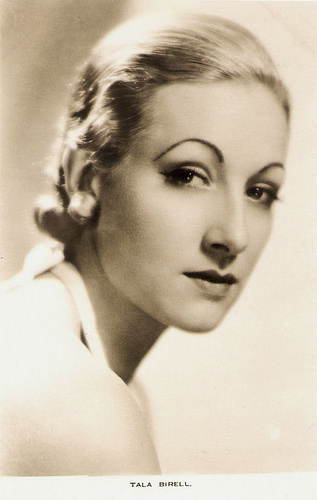
British postcard in the Film Weekly Series, London.
Poverty Row
In 1940 Tala Birell appeared onstage in My Dear Children at the Belasco Theatre in New York City.
During the 1940s she continued to appear in B-films like the action film Seven Miles from Alcatraz (Edward Dmytryk, 1942) with Bonita Granville, and One Dangerous Night (Michael Gordon, 1943), the ninth Lone Wolf film featuring Warren William as former jewel thief and reformed detective Michael Lanyard alias The Lone Wolf.
Her most often-seen performance is her brief role as the governess to the Empress's very young son in The Song of Bernadette (Henry King, 1943), who takes what is believed to be miraculous water from the grotto.
Her roles got smaller and she started to work for ‘poverty row’ studios as PRC and Monogram Pictures. For PRC she played in the Science Fiction/Horror movie The Monster Maker (Sam Newfield, 1944) starring J. Carrol Naish, and for Columbia she played in a film of another popular series, the mystery film noir The Power of the Whistler (Lew Landers, 1945) based on the radio drama The Whistler.
Several of her characters were linked with the anti-Nazi war effort: a courageous Russian in China (John Farrow, 1943), Madame Bouchard of the French Resistance in Till We Meet Again (Frank Borzage, 1944), the Nazi Doctor Elise Bork in the serial Jungle Queen (Lewis D. Collins, Ray Taylor, 1945), and Yvette Aubert, the French adventurer and entertainer in Women in the Night (William Rowland, 1948), who plays along with an extreme Nazi unit in Shanghai until she saves the world from a weapon of mass destruction with the sacrifice of her life.
After the war, she also had a small part in the biopic Song of Love (Clarence Brown, 1947) starring Katharine Hepburn as Clara Wieck.
Tirell returned to Germany and took up residence with her mother who was by then living in Munich. In 1951 she was appointed by the Special Service Headquarters of the U.S. Army in Nuremberg to organize theatrical productions in Germany, France, and Austria for the G.I.s. stationed there. Her title was Field Entertainment Supervisor, and sometimes took part herself in shows at military clubs in Munich and Nuremberg, and Orléans (France).
She later moved to Berlin with the title Command Entertainment Director and put on shows for U.S. troops and refugees from Eastern Europe. She retired in 1957 for health reasons.
Her final on-camera appearance was as the Queen of Cygni in an episode of the television series Flash Gordon (1955), based on the characters of the Alex Raymond-created comic strip.
Tala Birell died in 1958 in Landstuhl, Germany, aged 50. She is buried in the Bavarian village Marquartstein in a family tomb.
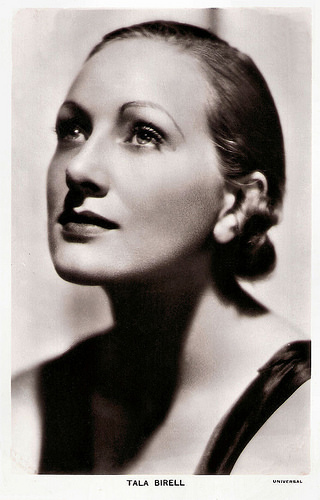
British postcard in the Picturegoer Series, no. 774. Photo: Universal.
Sources: L. Paul Meienberg (Films of the Golden Age), Hal Erickson (AllMovie), Wikipedia and .

German postcard by Ross Verlag, Berlin, no. 5327/1, 1930-1931. Photo: Manassé , Wien.
Max Reinhardt
Tall and blond Tala Birell was born as Natalie Bierl in Bucharest, Romania in 1907. Her mother Stephanie Sahaydakowska, was a Polish baroness, and her father, Carl Bierl, an Austrian businessman. They were temporarily in Bucharest while he was overseeing his company there.
Nathale and her three sisters and one brother enjoyed an idyllic life, summering at the Polish estate of her aristocratic uncle. During WWI the family was in Berlin, where Nathalie studied at a private school. After the war her father died and her privileged childhood came to an end.
She dreamed of the theatre, and made her stage debut in Berlin in 1926 in The Mikado with Erik Charell.
That year, she also made her film debut credited as Thala Birell in a bit role in Man spielt nicht mit der Liebe/One Does Not Play with Love (Georg Wilhelm Pabst, 1926), starring Werner Krauss and Lili Damita . This silent German drama was an adaptation of the play On ne badine pas avec l'amour by Alfred de Musset, and is now considered to be a lost film.
The following year she played in Ich habe im Mai von der Liebe geträumt/In May, I dreamed of love (Frans Seitz, 1927) with Wilhelm Dieterle .
She was spotted by the famous stage producer Max Reinhardt, who put her in his production of Es Liegt in Der Luft (It’s in the Air, 1927) starring Marlene Dietrich . Birell was an understudy for Dietrich’s role until Dietrich left the show. Tala then became the star and took the show to Vienna. As a Reinhardt protégé, her reputation grew.
In Austria she played the female lead in the film Die Tat des Andreas Harmer/The act of Andrew Harmer (Alfred Deutsch-German, 1930).
Next, she went to England to appear in the drama Menschen im Käfig/The Love Storm (Ewald André Dupont, 1930) starring Conrad Veidt . This was the German-language version of the British film Cape Forlorn (Ewald André Dupont, 1931).
Then, a Universal executive signed her to come to Hollywood for a part in Liebe auf Befehl (Ernst L. Frank, Johannes Riemann, 1931), the German version of The Boudoir Diplomat (Malcolm St. Clair, 1930) with Betty Compson.
She stayed in Hollywood and Universal gave her a leading role in Doomed Battalion (Cyril Gardner, 1932), the American version of a German mountain film starring Luis Trenker . It was a critical and artistic success and was voted one of the ten best films of 1932 by the New York Times. Next she appeared as a European countess in Nagana (Ernst L. Frank, 1933) opposite Melvyn Douglas.
The studio promoted her as a second Garbo, due to her glamorous, a bit cold beauty. But just as with another European import Anna Sten , the publicity did not work. Garbo was unique.
In the following years Tirell only played small roles for Columbia Pictures in films like The Captain Hates the Sea (Lewis Milestone, 1934). She got the female lead in B-films like the aviation-themed science-fiction film Air Hawks (Albert Rogell, 1935).
She also had supporting parts in A-films like the musical comedy Let's Live Tonight (Victor Schertzinger, 1935) starring Lilian Harvey , Crime and Punishment (Josef von Sternberg, 1935) starring Peter Lorre , and the classic screwball comedy Bringing Up Baby (Howard Hawks, 1938).

British postcard in the Film Weekly Series, London.
Poverty Row
In 1940 Tala Birell appeared onstage in My Dear Children at the Belasco Theatre in New York City.
During the 1940s she continued to appear in B-films like the action film Seven Miles from Alcatraz (Edward Dmytryk, 1942) with Bonita Granville, and One Dangerous Night (Michael Gordon, 1943), the ninth Lone Wolf film featuring Warren William as former jewel thief and reformed detective Michael Lanyard alias The Lone Wolf.
Her most often-seen performance is her brief role as the governess to the Empress's very young son in The Song of Bernadette (Henry King, 1943), who takes what is believed to be miraculous water from the grotto.
Her roles got smaller and she started to work for ‘poverty row’ studios as PRC and Monogram Pictures. For PRC she played in the Science Fiction/Horror movie The Monster Maker (Sam Newfield, 1944) starring J. Carrol Naish, and for Columbia she played in a film of another popular series, the mystery film noir The Power of the Whistler (Lew Landers, 1945) based on the radio drama The Whistler.
Several of her characters were linked with the anti-Nazi war effort: a courageous Russian in China (John Farrow, 1943), Madame Bouchard of the French Resistance in Till We Meet Again (Frank Borzage, 1944), the Nazi Doctor Elise Bork in the serial Jungle Queen (Lewis D. Collins, Ray Taylor, 1945), and Yvette Aubert, the French adventurer and entertainer in Women in the Night (William Rowland, 1948), who plays along with an extreme Nazi unit in Shanghai until she saves the world from a weapon of mass destruction with the sacrifice of her life.
After the war, she also had a small part in the biopic Song of Love (Clarence Brown, 1947) starring Katharine Hepburn as Clara Wieck.
Tirell returned to Germany and took up residence with her mother who was by then living in Munich. In 1951 she was appointed by the Special Service Headquarters of the U.S. Army in Nuremberg to organize theatrical productions in Germany, France, and Austria for the G.I.s. stationed there. Her title was Field Entertainment Supervisor, and sometimes took part herself in shows at military clubs in Munich and Nuremberg, and Orléans (France).
She later moved to Berlin with the title Command Entertainment Director and put on shows for U.S. troops and refugees from Eastern Europe. She retired in 1957 for health reasons.
Her final on-camera appearance was as the Queen of Cygni in an episode of the television series Flash Gordon (1955), based on the characters of the Alex Raymond-created comic strip.
Tala Birell died in 1958 in Landstuhl, Germany, aged 50. She is buried in the Bavarian village Marquartstein in a family tomb.

British postcard in the Picturegoer Series, no. 774. Photo: Universal.
Sources: L. Paul Meienberg (Films of the Golden Age), Hal Erickson (AllMovie), Wikipedia and .
Published on July 30, 2014 23:00
July 29, 2014
Maj-Britt Nilsson
Maj-Britt Nilsson (1924-2006) was the first leading lady of the great Swedish director Ingmar Bergman. She featured in three of his films of the early 1950s. Her later film work was pale in comparison, but she had an impressive stage career.
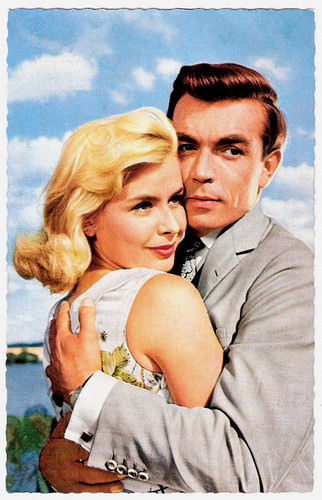
German postcard by Kolibri-Verlag, Minden/Westf. Photo: Constantin Film. Publicity still for Was die Schwalbe sang/What the swallow sang (Géza von Bolvary, 1956) with Claus Biederstadt .
Ingmar Bergman
Maj-Britt Nilsson was born in Stockholm in 1924. Aged 17, Nilsson got her first uncredited screen role as a schoolgirl in Tänk, om jag gifter mig med prästen/And If I Marry the Pastor (Ivar Johansson, 1941) starring Viveca Lindfors .
Nilsson gained experience in such films as Resan bort/A Journey Away (Alf Sjöberg, 1945). A few years later, she got her first leading parts, in Gustaf Molander's comedy Det är min modell/Affairs of a Model (1946) opposite Alf Kjellin, and the dramatic Maria (Gösta Folke, 1947).
At the same time, she studied at the drama school of the Royal Dramatic Theater in Stockholm, then under the direction of Mimi Pollak. Nilsson appeared in several plays of the Royal Dramatic Theater.
Her breakthrough came in 1948, when she and Anita Björk starred in a stage production of Jean Genet’s The Maids.
After this triumph Nilsson starred as a young wife of an adulterous orchestra player in the film Till Glädje/To Joy (1950), directed by the then 32 year old Ingmar Bergman. In his excellent obituary on Nilsson in The Guardian , Ronald Bergan wrote that the title of the film "derived from the choral movement of Ludwig von Beethoven's Ninth Symphony that ends the film on a note of hope. In it, as in many later films, Bergman focuses on the female face in close-up, and Nilsson's delicate features admirably bears the scrutiny of Gunnar Fischer's camera."
Bergman’s next film, Sommarlek/Summer Interlude (Ingmar Bergman, 1951), is generally considered as his first mature picture. For the female lead of a ballerina, he chose again the then 27-year-old Nilsson.
Ronald Bergan noted in The Guardian that this film was Bergman’s "first to create the atmosphere of nihilism and stark beauty that would become his trademark. (...) Summer Interlude dealt with adolescent love, the subject of much of Bergman's early work, and had Nilsson looking back on the idyllic summer she had spent several years earlier on an island near Stockholm with the boy she loved. But the affair comes to a tragic end when he dies in an accident. Nilsson, with the looks of a young, dark-haired Ingrid Bergman, brilliantly manages the shift from ecstatic young love to bitterness and emptiness, and then to the expression of a different kind of love."
At Alt Film Guide , Andre Soares cites Ingmar Bergman saying about Nilsson: "she could do anything. She did it instantly and delivered her lines with absolute naturalness."
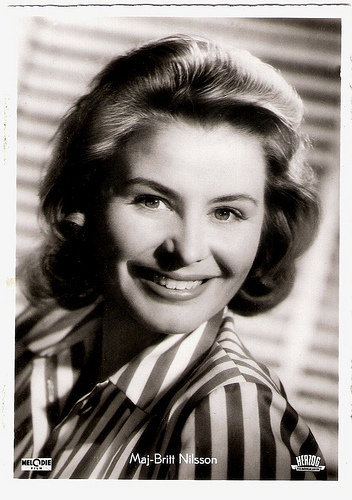
German postcard by Franz Josef Rüdel Filmpostkartenverlag, Hamburg-Bergedorf, no. W 1654. Photo: Melodie / Herzog-Film / A. Grimm. Publicity still for Sommarflickan/Schwedenmädel/Swedish Girl (Håkan Bergström, Thomas Engel, 1955).
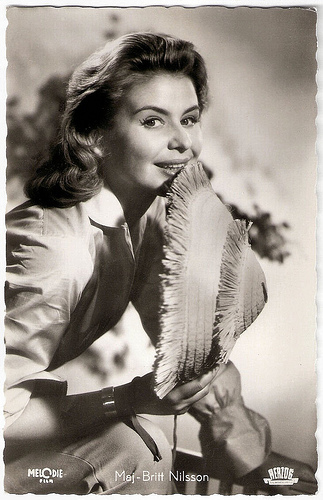
German postcard by Kolibri-Verlag G.m.b.H., Minden/Westf., no. 1662. Photo: Melodie / Sandrew / Herzog-Film / A. Grimm. Publicity still for Sommarflickan/Schwedenmädel/Swedish Girl (Håkan Bergström, Thomas Engel, 1955).
Björndal
In her third and last film for Bergman, Kvinnors Väntan/Waiting Women (Ingmar Bergman, 1952), Maj-Britt Nilsson played one of four waiting sisters-in-law - Anita Björk , Eva Dahlbeck, and Aino Taube are the others.
Ronald Bergan notes that the film is “a good example of the director's concern for relations between the sexes, especially from a woman's point of view. While the women of the title wait for their husbands to join them for the summer, three of them recount decisive incidents in their married lives. Nilsson's episode has her in hospital about to go into labour, a situation she has kept from her husband.”
Receiving rave reviews for her work, it was expected that she would become a main staple of Bergman's prestigious company of players. Surprisingly she never made another film for him.
In 1951, after a brief marriage to singer and composer Anders Börje, she had married Per Gerhard, a theatre director and son of Karl Gerhard, a prominent Swedish singer.
She subsequently left the Royal Dramatic Theatre to work alongside him at Stockholm's Vasa Theatre. The couple would stay there for the next three decades. One of her stage roles was that of Maggie the Cat in a Swedish-language version of Tennessee Williams' Cat on a Hot Tin Roof.
The films she later made in her career were of far less significance than her early work with Bergman. Among the more interesting ones are the Swedish film noir Vildfåglar/Wild Birds (Alf Sjöberg, 1955) with Per Oscarsson, the Swedish-German coproduction Sommarflickan/Schwedenmädel/Swedish Girl (Håkan Bergström, Thomas Engel, 1955) opposite Karlheinz Böhm , and Hollywood director John Cromwell's last film, A Matter of Morals (1961). The film was made in English in Sweden, with Nilsson carrying on an adulterous affair with her brother-in-law (Patrick O'Neal).
Nilsson seldom strayed outside her homeland when it came to filming outside the rare occasion of the two Austrian films based on the popular trilogy by Trygve Gulbranssen about the Norwegian Björndal family, Und ewig singen die Wälder/Beyond Sing the Woods (Paul May, 1959) and Das Erbe von Björndal/The Heritage of Bjorndal (Gustav Ucicky, 1960).
Her last film appearance was in Bluff Stop (Jonas Cornell, 1977), which featured Björn Andrésen, the boy from Morte a Venezia/Death in Venice (Luchino Visconti, 1971), by then 22, in his first film after Death in Venice.
She retired completely in 1985. In the 1980s she and her husband took up residence on the French Riviera.
In 2006, Maj-Britt Nilsson died in Cannes, France, aged 82.
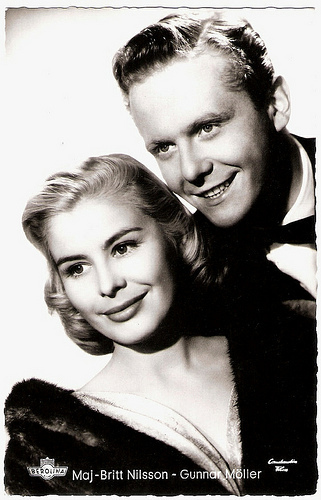
German postcard by Kolibri-Verlag, Minden/Westf., no. 2247. Photo: Berolina / Constantin / Wesel. Publicity still for Was die Schwalbe sang/What the swallow sang (Géza von Bolvary, 1956) with Gunnar Möller.
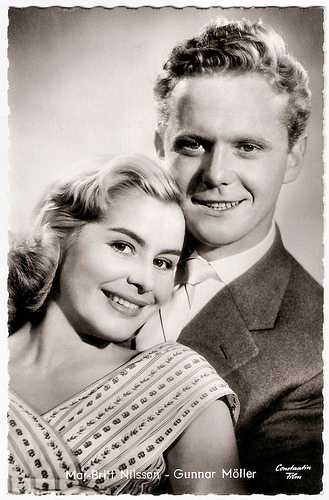
German postcard by Kolibri-Verlag, Minden/Westf. Photo: Constantin Film / Wesel. Publicity still for Was die Schwalbe sang/What the swallow sang (Géza von Bolvary, 1956) with Gunnar Möller.
Sources: Ronald Bergan (The Guardian), Andre Soares (Alt Film Guide), (IMDb), Wikipedia and .

German postcard by Kolibri-Verlag, Minden/Westf. Photo: Constantin Film. Publicity still for Was die Schwalbe sang/What the swallow sang (Géza von Bolvary, 1956) with Claus Biederstadt .
Ingmar Bergman
Maj-Britt Nilsson was born in Stockholm in 1924. Aged 17, Nilsson got her first uncredited screen role as a schoolgirl in Tänk, om jag gifter mig med prästen/And If I Marry the Pastor (Ivar Johansson, 1941) starring Viveca Lindfors .
Nilsson gained experience in such films as Resan bort/A Journey Away (Alf Sjöberg, 1945). A few years later, she got her first leading parts, in Gustaf Molander's comedy Det är min modell/Affairs of a Model (1946) opposite Alf Kjellin, and the dramatic Maria (Gösta Folke, 1947).
At the same time, she studied at the drama school of the Royal Dramatic Theater in Stockholm, then under the direction of Mimi Pollak. Nilsson appeared in several plays of the Royal Dramatic Theater.
Her breakthrough came in 1948, when she and Anita Björk starred in a stage production of Jean Genet’s The Maids.
After this triumph Nilsson starred as a young wife of an adulterous orchestra player in the film Till Glädje/To Joy (1950), directed by the then 32 year old Ingmar Bergman. In his excellent obituary on Nilsson in The Guardian , Ronald Bergan wrote that the title of the film "derived from the choral movement of Ludwig von Beethoven's Ninth Symphony that ends the film on a note of hope. In it, as in many later films, Bergman focuses on the female face in close-up, and Nilsson's delicate features admirably bears the scrutiny of Gunnar Fischer's camera."
Bergman’s next film, Sommarlek/Summer Interlude (Ingmar Bergman, 1951), is generally considered as his first mature picture. For the female lead of a ballerina, he chose again the then 27-year-old Nilsson.
Ronald Bergan noted in The Guardian that this film was Bergman’s "first to create the atmosphere of nihilism and stark beauty that would become his trademark. (...) Summer Interlude dealt with adolescent love, the subject of much of Bergman's early work, and had Nilsson looking back on the idyllic summer she had spent several years earlier on an island near Stockholm with the boy she loved. But the affair comes to a tragic end when he dies in an accident. Nilsson, with the looks of a young, dark-haired Ingrid Bergman, brilliantly manages the shift from ecstatic young love to bitterness and emptiness, and then to the expression of a different kind of love."
At Alt Film Guide , Andre Soares cites Ingmar Bergman saying about Nilsson: "she could do anything. She did it instantly and delivered her lines with absolute naturalness."

German postcard by Franz Josef Rüdel Filmpostkartenverlag, Hamburg-Bergedorf, no. W 1654. Photo: Melodie / Herzog-Film / A. Grimm. Publicity still for Sommarflickan/Schwedenmädel/Swedish Girl (Håkan Bergström, Thomas Engel, 1955).

German postcard by Kolibri-Verlag G.m.b.H., Minden/Westf., no. 1662. Photo: Melodie / Sandrew / Herzog-Film / A. Grimm. Publicity still for Sommarflickan/Schwedenmädel/Swedish Girl (Håkan Bergström, Thomas Engel, 1955).
Björndal
In her third and last film for Bergman, Kvinnors Väntan/Waiting Women (Ingmar Bergman, 1952), Maj-Britt Nilsson played one of four waiting sisters-in-law - Anita Björk , Eva Dahlbeck, and Aino Taube are the others.
Ronald Bergan notes that the film is “a good example of the director's concern for relations between the sexes, especially from a woman's point of view. While the women of the title wait for their husbands to join them for the summer, three of them recount decisive incidents in their married lives. Nilsson's episode has her in hospital about to go into labour, a situation she has kept from her husband.”
Receiving rave reviews for her work, it was expected that she would become a main staple of Bergman's prestigious company of players. Surprisingly she never made another film for him.
In 1951, after a brief marriage to singer and composer Anders Börje, she had married Per Gerhard, a theatre director and son of Karl Gerhard, a prominent Swedish singer.
She subsequently left the Royal Dramatic Theatre to work alongside him at Stockholm's Vasa Theatre. The couple would stay there for the next three decades. One of her stage roles was that of Maggie the Cat in a Swedish-language version of Tennessee Williams' Cat on a Hot Tin Roof.
The films she later made in her career were of far less significance than her early work with Bergman. Among the more interesting ones are the Swedish film noir Vildfåglar/Wild Birds (Alf Sjöberg, 1955) with Per Oscarsson, the Swedish-German coproduction Sommarflickan/Schwedenmädel/Swedish Girl (Håkan Bergström, Thomas Engel, 1955) opposite Karlheinz Böhm , and Hollywood director John Cromwell's last film, A Matter of Morals (1961). The film was made in English in Sweden, with Nilsson carrying on an adulterous affair with her brother-in-law (Patrick O'Neal).
Nilsson seldom strayed outside her homeland when it came to filming outside the rare occasion of the two Austrian films based on the popular trilogy by Trygve Gulbranssen about the Norwegian Björndal family, Und ewig singen die Wälder/Beyond Sing the Woods (Paul May, 1959) and Das Erbe von Björndal/The Heritage of Bjorndal (Gustav Ucicky, 1960).
Her last film appearance was in Bluff Stop (Jonas Cornell, 1977), which featured Björn Andrésen, the boy from Morte a Venezia/Death in Venice (Luchino Visconti, 1971), by then 22, in his first film after Death in Venice.
She retired completely in 1985. In the 1980s she and her husband took up residence on the French Riviera.
In 2006, Maj-Britt Nilsson died in Cannes, France, aged 82.

German postcard by Kolibri-Verlag, Minden/Westf., no. 2247. Photo: Berolina / Constantin / Wesel. Publicity still for Was die Schwalbe sang/What the swallow sang (Géza von Bolvary, 1956) with Gunnar Möller.

German postcard by Kolibri-Verlag, Minden/Westf. Photo: Constantin Film / Wesel. Publicity still for Was die Schwalbe sang/What the swallow sang (Géza von Bolvary, 1956) with Gunnar Möller.
Sources: Ronald Bergan (The Guardian), Andre Soares (Alt Film Guide), (IMDb), Wikipedia and .
Published on July 29, 2014 23:00
July 28, 2014
Marguerite Moreno
Marguerite Moreno (1871-1948) was a famous French stage and screen actress.
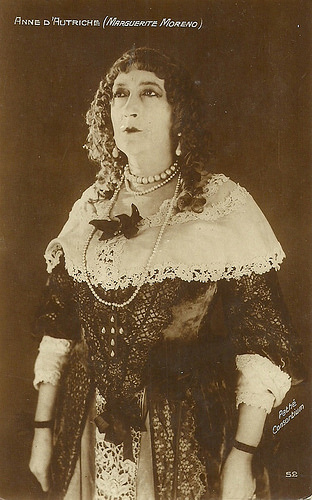
French postcard. Editions Cinémagazine, no. 52. Photo: Pathé Consortium Cinema. Marguerite Moreno as Anne d'Autriche in the Dumas adaptation Vingt ans après (Henri Diamant-Berger, 1922).
The Muse of the Symbolists
Marguerite Moreno was born in Paris in 1871. She was the daughter of Pierre Monceau, teacher in mathematics, and Charlotte Lucie Moreno.
Moreno studied in Paris and Bretagne, then entered the Paris Conservatoire, in the class of Gustave Worms. She was engaged by the Comédie-Française in 1890, and acted on stage with the famous names of the French stage: Charles Le Bargy , Mounet-Sully, Julia Bartet, Coquelin sr. and Paul Mounet.
She became the 'muse of the Symbolists', and poet Stéphane Mallarmé’s close friend, but nevertheless she didn’t manage to convince him to stage his Hérodiade. It was Moreno who in 1898 organised his funeral at he church and graveyard of Samoreau près la Seine where he had his country house.
After being the mistress of poet Catulle Mendès (their son would die of meningitis), Moreno married in Britain writer Marcel Schwob in 1900. Unfortunately Schwob fell ill and died in 1905, at the age of 37.
In 1903, Marguerite Moreno left the Comédie-Française and joined the Théâtre de Sarah Bernhardt, and afterwards the Théâtre Antoine.
In 1908 she remarried with actor Jean Daragon. For seven years she ran in Buenos Aires the French section of the Conservatory. When the First World War broke out, she was active at the military hospital in Nice.
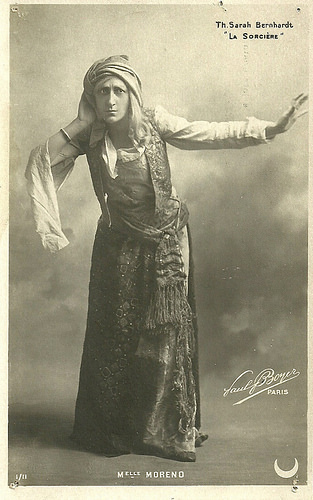
French postcard. Photo Saul Boyer, Paris, no. 1/11. Marguerite Moreno in La Sorcière at the Theatre Sarah Bernhardt, Paris. Moreno performed in this play by Victorien Sardou in 1903.
Ringed eyes and a rosebud mouth
From 1915, Marguerite Moreno discovered the cinema. In the silent era she played together with her second husband Jean Daragon in Vingt ans après (1922) by Henri Diamant-Berger.
Vingt ans après/Twenty Years After (1922) was the sequel to Les Trois Mousquetaires (1921), the first film version of Alexandre Dumas, père's novel The Three Musketeers. Both films were directed by Diamant-Berger.
Moreno impersonated Queen Anne of Austria “under a plaster-like make-up, with ringed eyes, and a rosebud mouth”, as Olivier Barrot and Raymond Chirat wrote in Noir & Blanc: 250 acteurs du cinéma français 1930-1960 (2000).
Daragon played Beaufort in Vingt ans après, but it was to be his last film. A year later, in 1923, he died.
Moreno acted in several other films by Diamant-Berger: Paris pendant la guerre (1916), Le Mauvais garçon (1923), opposite Maurice Chevalier in Gonzague (1923), L'Accordeur (1923) and L'Emprise (1924), starring Pierre de Guingand and Pierrette Madd .
In the late 1920s she also acted in films like Le Capitaine Fracasse by Alberto Cavalcanti (1929), starring Pierre Blanchar and Lien Deyers .
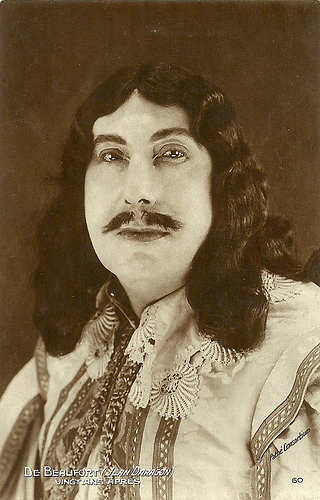
French postcard by Editions Cinémagazine, no. 60. Photo: Pathé Consortium Cinema. Jean Daragon as De Beaufort in the Dumas adaptation Vingt ans après (Henri Diamant-Berger, 1922).
Countesses, duchesses and queens
When sound cinema arrived in France, Moreno had an enormous increase in film roles. In 1930-1932 she played at least one film part each month, a number which slowly went down in the course of the 1930s.
On instigation of her friend and soulmate, the writer Colette, Moreno started playing comedy, and in 1920, she had had a big success on stage with Le Sexe faible by Édouard Bourdet. Here she played “an old Slavic countess who hires beautiful boys to pass boredom”, as Maurice Martin du Gard mentioned in his Carte rouge (1930).
Moreno repeated the part in the adaptation filmed by Robert Siodmak in 1933 and starring Victor Boucher. Moreno often played countesses, duchesses and queens, though she included the lower classes as well.
In the interbellum years Moreno installed herself in a an estate at the Lot province. It was renovated by her cousin, actor Pierre Moreno, who lived and acted with her and was her lover too.
Moreno spread her career between the stage and the screen, and according to Barrot and Chirat, “she accepted all that was offered her. The average spectator’s laugh at each of her performances was enough for her.”
She appeared e.g. in Un trou dans le mur (1930) by René Barberis, Tout va très bien madame la marquise (1936) by Henry Wulschleger, and La Fessée (1937) by Pierre Caron.
However, Moreno was also directed by Raymond Bernard in Les Misérables (1934), where she and Charles Dullin played the evil couple Thenardier opposite Harry Baur as Jean Valjean.
She played again aristocrats in Jean Delannoy's Paris-Deauville (1933) and in La dame de pique (1937) by Fedor Ozep.
She did various parts in films by Sacha Guitry: Faisons un rêve, Le Roman d'un tricheur and Le Mot de Cambronne in 1936, Les Perles de la couronne in 1937, Ils étaient neuf célibataires in 1939, and Donne-moi tes yeux in 1943.
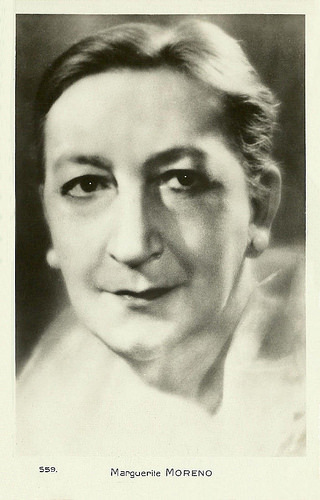
French postcard, no. 559. Collection: Didier Hanson.
You cannot be ugly with such an expressive face
Marguerite Moreno worked with several interesting film directors.
With Marcel Pagnol she played in Regain (1937) starring Fernandel , and the uncompleted film La Prière aux étoiles (1941).
With Christian-Jaque she made Carmen (1942) and Un revenant (1946) with Louis Jouvet , and with Claude Autant-Lara she acted in Douce (1943).
In 1945, Marguerite Moreno was a giant succes on stage as Aurélie in La Folle de Chaillot, written for her by Jean Giraudoux.
Marguerite Moreno died in Touzac (Lot) on 14 July 1948. Her last film, L'assassin est à l'écoute (Raoul André, 1948), was released a few weeks after her death.
Her house and estate La Source bleue (The Blue Source) in Touzac was transformed in an inn by her heirs.
Paul Valéry consided her the only one capable to recite poems, so he invited her to recite them during his courses at the Collège de France.
Paul Léautaud wrote on her: “Tonight while listening to Moreno in Aricie, I was crying softly…” and “People say she is ugly, but you cannot be ugly with such an expressive face, and so delicate at the same time – her eyes, her nose, her mouth are so full of wit. Moreover, she has it in such a way as seldom to be found in a woman. She is female malice and satire embodied.”
The Marguerite Moreno Papers were purchased by Yale University in 2009.
Sources: Wikipedia (French) and .

French postcard. Editions Cinémagazine, no. 52. Photo: Pathé Consortium Cinema. Marguerite Moreno as Anne d'Autriche in the Dumas adaptation Vingt ans après (Henri Diamant-Berger, 1922).
The Muse of the Symbolists
Marguerite Moreno was born in Paris in 1871. She was the daughter of Pierre Monceau, teacher in mathematics, and Charlotte Lucie Moreno.
Moreno studied in Paris and Bretagne, then entered the Paris Conservatoire, in the class of Gustave Worms. She was engaged by the Comédie-Française in 1890, and acted on stage with the famous names of the French stage: Charles Le Bargy , Mounet-Sully, Julia Bartet, Coquelin sr. and Paul Mounet.
She became the 'muse of the Symbolists', and poet Stéphane Mallarmé’s close friend, but nevertheless she didn’t manage to convince him to stage his Hérodiade. It was Moreno who in 1898 organised his funeral at he church and graveyard of Samoreau près la Seine where he had his country house.
After being the mistress of poet Catulle Mendès (their son would die of meningitis), Moreno married in Britain writer Marcel Schwob in 1900. Unfortunately Schwob fell ill and died in 1905, at the age of 37.
In 1903, Marguerite Moreno left the Comédie-Française and joined the Théâtre de Sarah Bernhardt, and afterwards the Théâtre Antoine.
In 1908 she remarried with actor Jean Daragon. For seven years she ran in Buenos Aires the French section of the Conservatory. When the First World War broke out, she was active at the military hospital in Nice.

French postcard. Photo Saul Boyer, Paris, no. 1/11. Marguerite Moreno in La Sorcière at the Theatre Sarah Bernhardt, Paris. Moreno performed in this play by Victorien Sardou in 1903.
Ringed eyes and a rosebud mouth
From 1915, Marguerite Moreno discovered the cinema. In the silent era she played together with her second husband Jean Daragon in Vingt ans après (1922) by Henri Diamant-Berger.
Vingt ans après/Twenty Years After (1922) was the sequel to Les Trois Mousquetaires (1921), the first film version of Alexandre Dumas, père's novel The Three Musketeers. Both films were directed by Diamant-Berger.
Moreno impersonated Queen Anne of Austria “under a plaster-like make-up, with ringed eyes, and a rosebud mouth”, as Olivier Barrot and Raymond Chirat wrote in Noir & Blanc: 250 acteurs du cinéma français 1930-1960 (2000).
Daragon played Beaufort in Vingt ans après, but it was to be his last film. A year later, in 1923, he died.
Moreno acted in several other films by Diamant-Berger: Paris pendant la guerre (1916), Le Mauvais garçon (1923), opposite Maurice Chevalier in Gonzague (1923), L'Accordeur (1923) and L'Emprise (1924), starring Pierre de Guingand and Pierrette Madd .
In the late 1920s she also acted in films like Le Capitaine Fracasse by Alberto Cavalcanti (1929), starring Pierre Blanchar and Lien Deyers .

French postcard by Editions Cinémagazine, no. 60. Photo: Pathé Consortium Cinema. Jean Daragon as De Beaufort in the Dumas adaptation Vingt ans après (Henri Diamant-Berger, 1922).
Countesses, duchesses and queens
When sound cinema arrived in France, Moreno had an enormous increase in film roles. In 1930-1932 she played at least one film part each month, a number which slowly went down in the course of the 1930s.
On instigation of her friend and soulmate, the writer Colette, Moreno started playing comedy, and in 1920, she had had a big success on stage with Le Sexe faible by Édouard Bourdet. Here she played “an old Slavic countess who hires beautiful boys to pass boredom”, as Maurice Martin du Gard mentioned in his Carte rouge (1930).
Moreno repeated the part in the adaptation filmed by Robert Siodmak in 1933 and starring Victor Boucher. Moreno often played countesses, duchesses and queens, though she included the lower classes as well.
In the interbellum years Moreno installed herself in a an estate at the Lot province. It was renovated by her cousin, actor Pierre Moreno, who lived and acted with her and was her lover too.
Moreno spread her career between the stage and the screen, and according to Barrot and Chirat, “she accepted all that was offered her. The average spectator’s laugh at each of her performances was enough for her.”
She appeared e.g. in Un trou dans le mur (1930) by René Barberis, Tout va très bien madame la marquise (1936) by Henry Wulschleger, and La Fessée (1937) by Pierre Caron.
However, Moreno was also directed by Raymond Bernard in Les Misérables (1934), where she and Charles Dullin played the evil couple Thenardier opposite Harry Baur as Jean Valjean.
She played again aristocrats in Jean Delannoy's Paris-Deauville (1933) and in La dame de pique (1937) by Fedor Ozep.
She did various parts in films by Sacha Guitry: Faisons un rêve, Le Roman d'un tricheur and Le Mot de Cambronne in 1936, Les Perles de la couronne in 1937, Ils étaient neuf célibataires in 1939, and Donne-moi tes yeux in 1943.

French postcard, no. 559. Collection: Didier Hanson.
You cannot be ugly with such an expressive face
Marguerite Moreno worked with several interesting film directors.
With Marcel Pagnol she played in Regain (1937) starring Fernandel , and the uncompleted film La Prière aux étoiles (1941).
With Christian-Jaque she made Carmen (1942) and Un revenant (1946) with Louis Jouvet , and with Claude Autant-Lara she acted in Douce (1943).
In 1945, Marguerite Moreno was a giant succes on stage as Aurélie in La Folle de Chaillot, written for her by Jean Giraudoux.
Marguerite Moreno died in Touzac (Lot) on 14 July 1948. Her last film, L'assassin est à l'écoute (Raoul André, 1948), was released a few weeks after her death.
Her house and estate La Source bleue (The Blue Source) in Touzac was transformed in an inn by her heirs.
Paul Valéry consided her the only one capable to recite poems, so he invited her to recite them during his courses at the Collège de France.
Paul Léautaud wrote on her: “Tonight while listening to Moreno in Aricie, I was crying softly…” and “People say she is ugly, but you cannot be ugly with such an expressive face, and so delicate at the same time – her eyes, her nose, her mouth are so full of wit. Moreover, she has it in such a way as seldom to be found in a woman. She is female malice and satire embodied.”
The Marguerite Moreno Papers were purchased by Yale University in 2009.
Sources: Wikipedia (French) and .
Published on July 28, 2014 23:00
July 27, 2014
Roland Verhavert (1927-2014)
Om Friday 26 July 2014, Belgian film director Roland Verhavert passed away. He directed 44 films between 1955 and 1993. In 1955, he had his breakthrough when he co-directed the film Meeuwen sterven in de haven/Seagulls Die in the Harbour (1955), which was entered into the 1956 Cannes Film Festival. In 1974, his film De loteling/The Conscript (1973) was entered into the 24th Berlin International Film Festival. Verhavert died of a heart attack, aged 87.
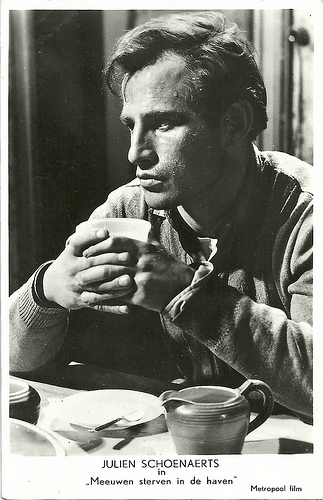
Belgian postcard by Ed. Prevot, Antwerp. Photo: Metropool Film. Publicity still for Meeuwen sterven in de haven/Seagulls Die in the Harbour (1955) with Julien Schoenaerts.
Seagulls die in the harbour
Meeuwen sterven in de haven/Seagulls die in the harbour/Les mouettes meurent au port (1955) was a Belgian thriller, directed by Roland Verhavert, Rik Kuypers and Ivo Michiels, who also wrote the script.
It starred Julien Schoenaerts as the stranger and Dora van der Groen as a prostitute, but also the city itself played an important part.
The story deals with a tormented, nameless man, on the run after the murder on his wife, ending up in harbour town Antwerp. He is only understood by a little orphan and two women who want to help him, but then others force him to kidnap the child.
The film meant the film debut of Schoenaerts and was also the breakthrough for Van der Groen as film actress. Because of its theme and its expressionist style, the film reminds of The Third Man (Carol Reed, 1949) and On the Waterfront (Elia Kazan, 1954).
Meeuwen sterven in de haven/Seagulls Die in the Harbour was well received nationally and internationally, and was selected for festivals like Cannes, where it was even nominated for a Golden Palm.
After being shown at the Belgian Week in Moscow, the film was sold to the Soviet Union where it became a hit.
In Belgium it was praised for its fresh look and - in contrast to the usual local comedies - its international appeal. Flemish critics hailed it as the first Flemish film, others even as the first Belgian one.
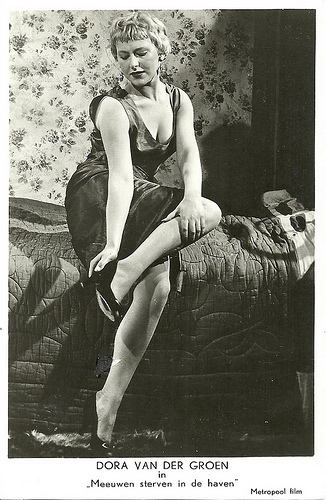
Belgian postcard by Ed. Prevot, Antwerp. Photo: Metropool Film. Publicity still for Meeuwen sterven in de haven/Seagulls Die in the Harbour (1955) with Dora van der Groen.
Source: Wikipedia (Dutch, French and English) and .

Belgian postcard by Ed. Prevot, Antwerp. Photo: Metropool Film. Publicity still for Meeuwen sterven in de haven/Seagulls Die in the Harbour (1955) with Julien Schoenaerts.
Seagulls die in the harbour
Meeuwen sterven in de haven/Seagulls die in the harbour/Les mouettes meurent au port (1955) was a Belgian thriller, directed by Roland Verhavert, Rik Kuypers and Ivo Michiels, who also wrote the script.
It starred Julien Schoenaerts as the stranger and Dora van der Groen as a prostitute, but also the city itself played an important part.
The story deals with a tormented, nameless man, on the run after the murder on his wife, ending up in harbour town Antwerp. He is only understood by a little orphan and two women who want to help him, but then others force him to kidnap the child.
The film meant the film debut of Schoenaerts and was also the breakthrough for Van der Groen as film actress. Because of its theme and its expressionist style, the film reminds of The Third Man (Carol Reed, 1949) and On the Waterfront (Elia Kazan, 1954).
Meeuwen sterven in de haven/Seagulls Die in the Harbour was well received nationally and internationally, and was selected for festivals like Cannes, where it was even nominated for a Golden Palm.
After being shown at the Belgian Week in Moscow, the film was sold to the Soviet Union where it became a hit.
In Belgium it was praised for its fresh look and - in contrast to the usual local comedies - its international appeal. Flemish critics hailed it as the first Flemish film, others even as the first Belgian one.

Belgian postcard by Ed. Prevot, Antwerp. Photo: Metropool Film. Publicity still for Meeuwen sterven in de haven/Seagulls Die in the Harbour (1955) with Dora van der Groen.
Source: Wikipedia (Dutch, French and English) and .
Published on July 27, 2014 23:00
July 26, 2014
A donation of rare postcards and other memorabilia
When we returned from our holidays in Italy, there was this little package from East-Hartford, USA, waiting for us at our neighbour's house. It contained rare postcards, photos and a clipping on the silent, Ukrainian-born film star Xenia Desni and her daughter Tamara Desni, who had an impressive film and stage career herself in Great Britain. Of course, we were very happy with the content. The postcards were sent to us by a relative of the Desni's, their niece Tatiana. In the past, Tatiana already had sent us some scans of the postcards of Tamara Desni and she gave us 39 Ross postcards, which she had collected as a little girl. EFSP did a
post
on this collection. And of course, we share this beautiful new donation with you too.

Austrian photo by Willinger, Wien. From Tatiana. Xenia Desni and Livio Pavanelli in the German silent film Die letzte Einquartierung aka Küssen ist keine Sünd'/Kissing is no sin (Rudolf Walther-Fein, Rudolf Dworsky, 1926).
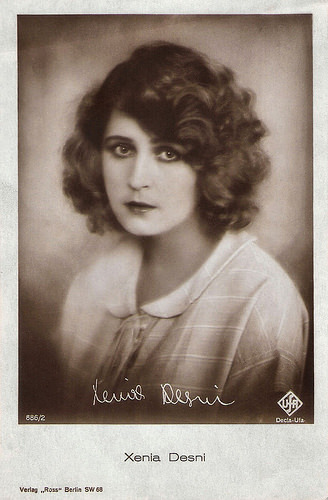
German postcard by Ross Verlag, no. 886/2, 1925-1926. Photo: Decla / Ufa. From Tatiana.
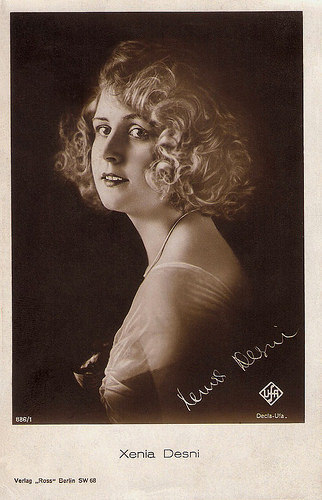
German postcard by Ross Verlag, no. 886/1, 1925-1926. Photo: Decla / Ufa. From Tatiana.
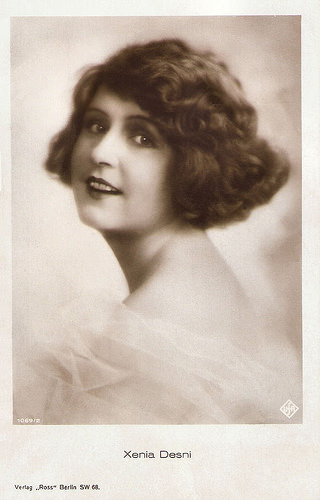
German postcard by Ross Verlag, no. 1069/2, 1927-1928. Photo: Ufa. From Tatiana.
Xenia Desni
Ukrainian-born actress Xenia Desni (1894-1954) was a star of the German silent cinema. Xenia - also known as Dada - was born in Kiev, but travelled at the beginning of the 1920s to Berlin.
She made her film debut with Sappho (Dimitri Buchowetzki, 1921). She often worked with director Johannes Guter such as for her breakthrough film Die Prinzessin Suwarin/The Princess Suwarin (1923) starring Lil Dagover .
In the next years followed other successful productions such as Die Andere/The Other (Gerhard Lamprecht, 1924). An international hit became the silent operetta Ein Walzertraum/A Waltz Dream (Ludwig Berger, 1925) with Willy Fritsch .
This was followed by Familie Schimeck/The Schimeck Family (Alfred Halm, Rudolf Dworsky, 1926), Madame wagt einen Seitensprung/Madam dares an Escapade (Hans Otto, 1927), and Erzherzog Johann/Archduke John (Max Neufeld, 1929).
After the coming of sound film, her career soon ended. But Xenia helped to shape the film and stage career of her beautiful daughter.
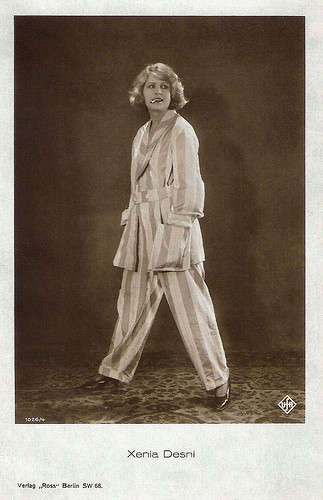
German postcard by Ross Verlag, no. 1026/4, 1927-1928. Photo: Ufa. From Tatiana.
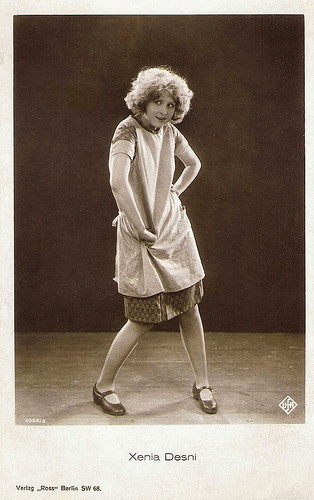
German postcard by Ross Verlag, no. 1028/2, 1927-1928. Photo: Ufa. From Tatiana.
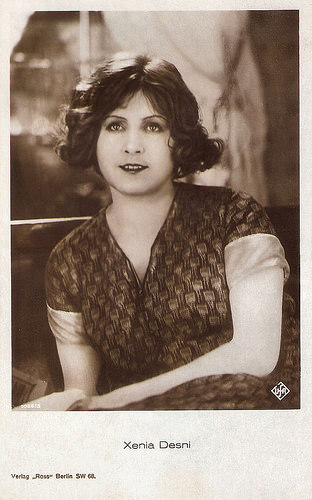
German postcard by Ross Verlag, no. 1026/3, 1927-1928. Photo: Ufa. From Tatiana.
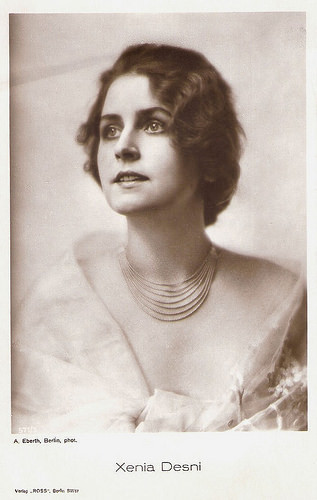
German postcard by Ross Verlag, no. 571/3, 1919-1924. Photo: A. Eberth, Berlin. From Tatiana.
Tamara Desni
Tamara Desni (1910–2008) started her stage and film career as a child in Berlin. Tamara acted in three German sound films before leaving with her mother to Great Britain.
In 1931, she made her triumphant London stage debut in the operetta White Horse Inn. For this spectacular production, the entire Coliseum theatre was transformed into the Tyrol. The production was based on the German operetta Im weissen Roessl. White Horse Inn was a smash hit and ran for 500 performances at the Coliseum. The production is even credited with saving the theatre, which was faltering as a music hall.
Tamara followed this up with another leading role in a German import at the Coliseum, the musical Casanova, featuring music by Johann Strauss, Jr.
Desni's British film career took off with the comedy Falling for You (Robert Stevenson, Jack Hulbert, 1933), supporting the popular musical comedy team of Jack Hulbert and Cicely Courtneidge .
Later films included the thriller Forbidden Territory (Phil Rosen, 1934), another Jack Hulbert comedy Jack Ahoy (Walter Forde, 1935) and the historical drama Fire Over England (William K. Howard, 1937), with Laurence Olivier and Vivien Leigh .
Tamara Desni’s film career continued through 1950. After that she moved to the South of France, where her bar and restaurant L'Auberge Chez Tamara, became a popular attraction around Grasse in the Alpes Maritimes.
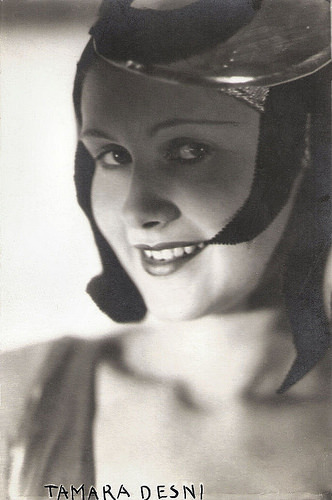
German postcard for Otto Kurt Vogelsang Lichtbildner, Berlin. From Tatiana.
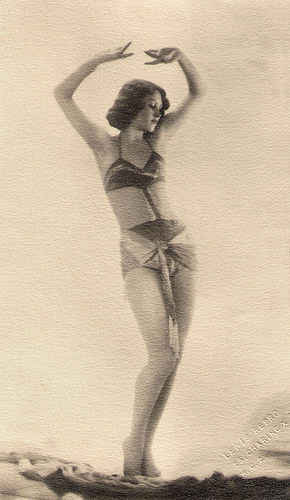
British postcard. From Tatiana.
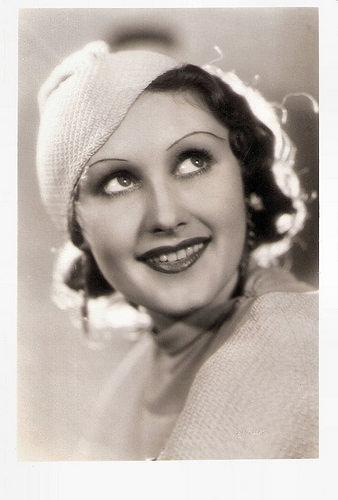
British postcard. From Tatiana.
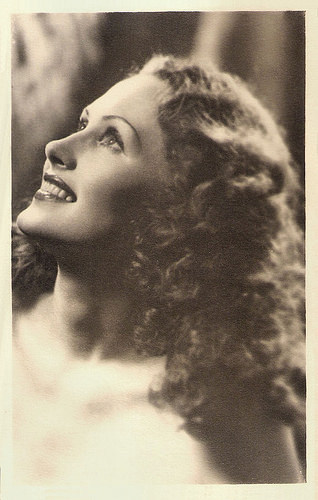
British photo by Vivienne 20th Century Studios Ltd, London. From Tatiana.
Dear Tatiana, thank you so much for this wonderful donation!

Austrian photo by Willinger, Wien. From Tatiana. Xenia Desni and Livio Pavanelli in the German silent film Die letzte Einquartierung aka Küssen ist keine Sünd'/Kissing is no sin (Rudolf Walther-Fein, Rudolf Dworsky, 1926).

German postcard by Ross Verlag, no. 886/2, 1925-1926. Photo: Decla / Ufa. From Tatiana.

German postcard by Ross Verlag, no. 886/1, 1925-1926. Photo: Decla / Ufa. From Tatiana.

German postcard by Ross Verlag, no. 1069/2, 1927-1928. Photo: Ufa. From Tatiana.
Xenia Desni
Ukrainian-born actress Xenia Desni (1894-1954) was a star of the German silent cinema. Xenia - also known as Dada - was born in Kiev, but travelled at the beginning of the 1920s to Berlin.
She made her film debut with Sappho (Dimitri Buchowetzki, 1921). She often worked with director Johannes Guter such as for her breakthrough film Die Prinzessin Suwarin/The Princess Suwarin (1923) starring Lil Dagover .
In the next years followed other successful productions such as Die Andere/The Other (Gerhard Lamprecht, 1924). An international hit became the silent operetta Ein Walzertraum/A Waltz Dream (Ludwig Berger, 1925) with Willy Fritsch .
This was followed by Familie Schimeck/The Schimeck Family (Alfred Halm, Rudolf Dworsky, 1926), Madame wagt einen Seitensprung/Madam dares an Escapade (Hans Otto, 1927), and Erzherzog Johann/Archduke John (Max Neufeld, 1929).
After the coming of sound film, her career soon ended. But Xenia helped to shape the film and stage career of her beautiful daughter.

German postcard by Ross Verlag, no. 1026/4, 1927-1928. Photo: Ufa. From Tatiana.

German postcard by Ross Verlag, no. 1028/2, 1927-1928. Photo: Ufa. From Tatiana.

German postcard by Ross Verlag, no. 1026/3, 1927-1928. Photo: Ufa. From Tatiana.

German postcard by Ross Verlag, no. 571/3, 1919-1924. Photo: A. Eberth, Berlin. From Tatiana.
Tamara Desni
Tamara Desni (1910–2008) started her stage and film career as a child in Berlin. Tamara acted in three German sound films before leaving with her mother to Great Britain.
In 1931, she made her triumphant London stage debut in the operetta White Horse Inn. For this spectacular production, the entire Coliseum theatre was transformed into the Tyrol. The production was based on the German operetta Im weissen Roessl. White Horse Inn was a smash hit and ran for 500 performances at the Coliseum. The production is even credited with saving the theatre, which was faltering as a music hall.
Tamara followed this up with another leading role in a German import at the Coliseum, the musical Casanova, featuring music by Johann Strauss, Jr.
Desni's British film career took off with the comedy Falling for You (Robert Stevenson, Jack Hulbert, 1933), supporting the popular musical comedy team of Jack Hulbert and Cicely Courtneidge .
Later films included the thriller Forbidden Territory (Phil Rosen, 1934), another Jack Hulbert comedy Jack Ahoy (Walter Forde, 1935) and the historical drama Fire Over England (William K. Howard, 1937), with Laurence Olivier and Vivien Leigh .
Tamara Desni’s film career continued through 1950. After that she moved to the South of France, where her bar and restaurant L'Auberge Chez Tamara, became a popular attraction around Grasse in the Alpes Maritimes.

German postcard for Otto Kurt Vogelsang Lichtbildner, Berlin. From Tatiana.

British postcard. From Tatiana.

British postcard. From Tatiana.

British photo by Vivienne 20th Century Studios Ltd, London. From Tatiana.
Dear Tatiana, thank you so much for this wonderful donation!
Published on July 26, 2014 23:00
July 25, 2014
Oskar Werner
Talented Austrian actor Oskar Werner (1922-1984) was Jules in François Truffaut’s Nouvelle Vague classic Jules et Jim (1962). He is also known for international films like Ship of Fools (1965), The Spy Who Came in from the Cold (1965), Fahrenheit 451 (1966) and The Shoes of the Fisherman (1968). Werner received an Academy Award nomination and won a Golden Globe Award in 1966.
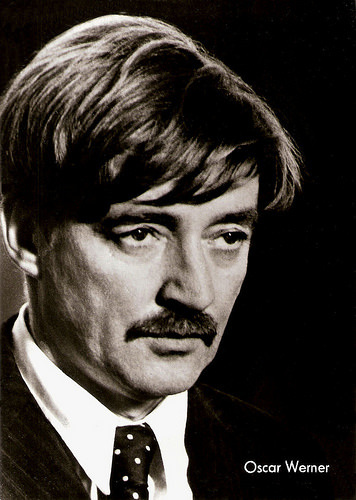
East-German postcard by VEB Progress Filmvertrieb, Berlin, no. 12/80, 1979. Photo: publicity still for Voyage of the Damned (Stuart Rosenberg, 1976).
Decision Before Dawn
Oskar Werner or Oscar Werner was born Oskar Josef Schließmayer in Vienna, Austria in 1922.
His parents divorced when he was fairly young. Oskar spent much of his childhood in the care of his grandmother, who entertained him with stories about the Burgtheater, the Austrian state theatre.
Performing in school plays also aroused a deep desire to act. His father ( Wikipedia ) or his uncle ( IMDb ) helped him to get parts as an extra in films like Geld fällt vom Himmel/Money falls from the sky (Heinz Helbig, 1938) and Hotel Sacher (Erich Engel, 1939).
He decided to drop out of high school in order to pursue acting roles. In 1940, director Lothar Müthel accepted the then eighteen years old as a member of the Burgtheater. Oskar was the youngest person ever to receive this recognition.
He made his theatre debut using the stage name Oskar Werner in October 1941. Two months later, Werner was drafted into the Wehrmacht.
As a pacifist and staunch opponent of National Socialism, he was determined to avoid advancement in the military. He finagled his way into KP duty feigning incompetence and was assigned to peeling potatoes and cleaning latrines instead of being sent to the Eastern Front.
In 1944, he secretly married actress Elisabeth Kallina, who was half-Jewish. They immediately had a daughter, Eleanore. That December, he deserted the Wehrmacht and fled with his wife and daughter to the Wienerwald, where they remained in hiding until the end of the war.
Werner returned to the Burgtheater, and also acted in productions at the Raimund Theater and the Theater in der Josefstadt, frequently playing character roles.
He made his film debut in Der Engel mit der Posaune/The angel with the trumpet (Karl Hartl, 1948). The following year he portrayed Ludwig van Beethoven's nephew Karl in Eroica (Walter Kolm-Veltée, 1949).
In 1950, Werner journeyed to the United Kingdom to reprise the role he had played in Der Engel mit der Posaune in its English-language version, The Angel with the Trumpet, under the direction of Anthony Bushell.
He and his wife divorced at about this time but remained friends.
He appeared in a few more German–Austrian films before going to Hollywood for a lead role as a German prisoner of war in the war film Decision Before Dawn (Anatole Litvak, 1951) opposite Richard Baseheart. The 20th Century Fox production was nominated for Academy Awards for Best Film Editing and Best Picture.
Werner was ripe for film stardom, but the subsequent roles promised by the studio failed to materialize. Hurt and disappointed, he returned to Europe and settled in Triesen, Liechtenstein, in a home he designed and built with a friend.
He returned to the stage and during the 1950’s he performed in Hamlet, Danton's Death, Henry IV, Henry V, Torquato Tasso, and Becket, among others.
In 1954 he married Anne Power, the daughter of French actress Annabella and adopted daughter of Tyrone Power.
After a period of inactivity in the cinema, Werner appeared in five films in 1955. Among them were the war drama Der letzte Akt/The Last Ten Days (Georg Wilhelm Pabst, 1955) about Hitler’s last ten days, Mozart/The Life and Loves of Mozart (Karl Hartl, 1955), in which he played the title role, and Lola Montès (Max Ophüls, 1955) as a student opposite Martine Carol .
Gary Brumburgh describes him at IMDb as “An aloof, handsome blond with wide-set, hooded eyes and quietly solemn features”. Despite his good looks and obvious talent, it would take seven more years before he began to draw critical acclaim and international recognition in the cinema.
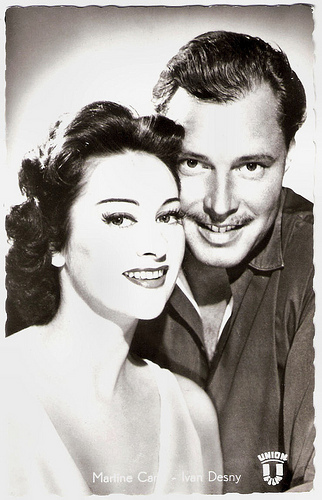
German postcard by Kolibri-Verlag G.m.b.H. Minden/Westf., no. 1719. Photo: Gamma / Union / Vogelmann. Publicity still for Lola Montez (Max Ophüls, 1955) with Martine Carol and Ivan Desny .
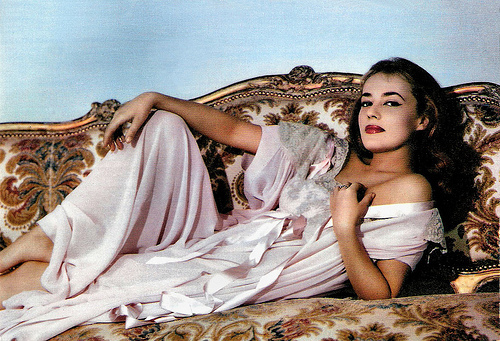
Jeanne Moreau . French postcard by Editions P.I., Paris, no. 1017. Photo: Sam Lévin .
Jules et Jim
In 1962, Oskar Werner's final breakthrough came with the French film Jules et Jim/Jules and Jim (François Truffaut, 1962) based on Henri-Pierre Roché's semi-autobiographical novel about his relationship with writer Franz Hessel and his wife, Helen Grund.
Werner became an international sensation as the highly romantic and intellectual Austrian Jules who falls in love with the same woman, Catherine ( Jeanne Moreau ), as his best friend Jim (Henri Serre).
Jules et Jim is one of the seminal products of the Nouvelle Vague, the French New Wave. Wikipedia describes it as “an inventive encyclopedia of the language of cinema that incorporates newsreel footage, photographic stills, freeze frames, panning shots, wipes, masking, dolly shots, and voiceover narration (by Michel Subor).”
Werner's then portrayed the philosophical Dr. Schumann in Ship of Fools (Stanley Kramer 1965), which recounts the overlapping stories of several passengers aboard an ocean liner bound to Germany from Mexico in 1933. His role won him the New York Film Critics Circle Award for Best Actor and nominations for the Academy Award for Best Actor, the Golden Globe Award for Best Actor – Motion Picture Drama, and the BAFTA Award for Best Foreign Actor.
His portrayal of Jewish East German spy Fiedler in The Spy Who Came in from the Cold (Martin Ritt, 1965) won him another Golden Globe Award and his second BAFTA nomination. Gary Brumburgh calls Werner’s acting style “remote, rather morose and, as a result, intriguing“.
In 1966, he played book-burning fireman Guy Montag in François Truffaut's film adaptation of the cult-classic Fahrenheit 451 by Ray Bradbury. The relationship with Truffaut was irreparably damaged over artistic differences while filming. The unhappiness of that film experience triggered an already burgeoning drinking problem and the decline of his career.
Werner next played an orchestra conductor in the British drama Interlude (Kevin Billington, 1968) and a Vatican priest loosely based on Pierre Teilhard de Chardin in the American drama The Shoes of the Fisherman (Michael Anderson, 1968).
That same year he divorced Power and put his film career on a hold. He returned to the stage and spent time travelling in Israel, Italy, Malta, France, and the United States.
He appeared in an episode of the TV series Columbo (Bernard L. Kowalski, 1975) featuring Peter Falk, and the following year he made his final screen appearance in Voyage of the Damned (Stuart Rosenberg, 1976) as Faye Dunaway’s Jewish husband.
The story was inspired by true events concerning the fate of the MS St. Louis ocean liner carrying Jewish refugees from Germany to Cuba in 1939. For his part he received another Golden Globe nomination.
Werner was an alcoholic, which was a deciding factor in the decline of his health and career. He lived most of the time retired in his house in Liechtenstein. His last stage appearance was in a 1983 production of The Prince of Homburg, and his last public appearance was at the Mozart Hall in Salzburg ten days prior to his death.
On 22 October 1984, Werner cancelled a reading at the Hotel Europäischer Hof in Marburg because he was feeling ill. He was found dead of a heart attack the following morning, only two days after François Truffaut had died.
Oskar Werner was 61. He is buried in his adopted country of Liechtenstein.
He had two children, his daughter Elinore (1944) with Elisabeth Kallina, and son Felix (1966) with the American model Diane Anderson.
Trailer Decision Before Dawn (1951). Source: UmbrellaEntAU (YouTube).
Trailer Jules et Jim/Jules and Jim (1962). Source: UmbrellaEntAU (YouTube).
Sources: (IMDb), Wikipedia, and .

East-German postcard by VEB Progress Filmvertrieb, Berlin, no. 12/80, 1979. Photo: publicity still for Voyage of the Damned (Stuart Rosenberg, 1976).
Decision Before Dawn
Oskar Werner or Oscar Werner was born Oskar Josef Schließmayer in Vienna, Austria in 1922.
His parents divorced when he was fairly young. Oskar spent much of his childhood in the care of his grandmother, who entertained him with stories about the Burgtheater, the Austrian state theatre.
Performing in school plays also aroused a deep desire to act. His father ( Wikipedia ) or his uncle ( IMDb ) helped him to get parts as an extra in films like Geld fällt vom Himmel/Money falls from the sky (Heinz Helbig, 1938) and Hotel Sacher (Erich Engel, 1939).
He decided to drop out of high school in order to pursue acting roles. In 1940, director Lothar Müthel accepted the then eighteen years old as a member of the Burgtheater. Oskar was the youngest person ever to receive this recognition.
He made his theatre debut using the stage name Oskar Werner in October 1941. Two months later, Werner was drafted into the Wehrmacht.
As a pacifist and staunch opponent of National Socialism, he was determined to avoid advancement in the military. He finagled his way into KP duty feigning incompetence and was assigned to peeling potatoes and cleaning latrines instead of being sent to the Eastern Front.
In 1944, he secretly married actress Elisabeth Kallina, who was half-Jewish. They immediately had a daughter, Eleanore. That December, he deserted the Wehrmacht and fled with his wife and daughter to the Wienerwald, where they remained in hiding until the end of the war.
Werner returned to the Burgtheater, and also acted in productions at the Raimund Theater and the Theater in der Josefstadt, frequently playing character roles.
He made his film debut in Der Engel mit der Posaune/The angel with the trumpet (Karl Hartl, 1948). The following year he portrayed Ludwig van Beethoven's nephew Karl in Eroica (Walter Kolm-Veltée, 1949).
In 1950, Werner journeyed to the United Kingdom to reprise the role he had played in Der Engel mit der Posaune in its English-language version, The Angel with the Trumpet, under the direction of Anthony Bushell.
He and his wife divorced at about this time but remained friends.
He appeared in a few more German–Austrian films before going to Hollywood for a lead role as a German prisoner of war in the war film Decision Before Dawn (Anatole Litvak, 1951) opposite Richard Baseheart. The 20th Century Fox production was nominated for Academy Awards for Best Film Editing and Best Picture.
Werner was ripe for film stardom, but the subsequent roles promised by the studio failed to materialize. Hurt and disappointed, he returned to Europe and settled in Triesen, Liechtenstein, in a home he designed and built with a friend.
He returned to the stage and during the 1950’s he performed in Hamlet, Danton's Death, Henry IV, Henry V, Torquato Tasso, and Becket, among others.
In 1954 he married Anne Power, the daughter of French actress Annabella and adopted daughter of Tyrone Power.
After a period of inactivity in the cinema, Werner appeared in five films in 1955. Among them were the war drama Der letzte Akt/The Last Ten Days (Georg Wilhelm Pabst, 1955) about Hitler’s last ten days, Mozart/The Life and Loves of Mozart (Karl Hartl, 1955), in which he played the title role, and Lola Montès (Max Ophüls, 1955) as a student opposite Martine Carol .
Gary Brumburgh describes him at IMDb as “An aloof, handsome blond with wide-set, hooded eyes and quietly solemn features”. Despite his good looks and obvious talent, it would take seven more years before he began to draw critical acclaim and international recognition in the cinema.

German postcard by Kolibri-Verlag G.m.b.H. Minden/Westf., no. 1719. Photo: Gamma / Union / Vogelmann. Publicity still for Lola Montez (Max Ophüls, 1955) with Martine Carol and Ivan Desny .

Jeanne Moreau . French postcard by Editions P.I., Paris, no. 1017. Photo: Sam Lévin .
Jules et Jim
In 1962, Oskar Werner's final breakthrough came with the French film Jules et Jim/Jules and Jim (François Truffaut, 1962) based on Henri-Pierre Roché's semi-autobiographical novel about his relationship with writer Franz Hessel and his wife, Helen Grund.
Werner became an international sensation as the highly romantic and intellectual Austrian Jules who falls in love with the same woman, Catherine ( Jeanne Moreau ), as his best friend Jim (Henri Serre).
Jules et Jim is one of the seminal products of the Nouvelle Vague, the French New Wave. Wikipedia describes it as “an inventive encyclopedia of the language of cinema that incorporates newsreel footage, photographic stills, freeze frames, panning shots, wipes, masking, dolly shots, and voiceover narration (by Michel Subor).”
Werner's then portrayed the philosophical Dr. Schumann in Ship of Fools (Stanley Kramer 1965), which recounts the overlapping stories of several passengers aboard an ocean liner bound to Germany from Mexico in 1933. His role won him the New York Film Critics Circle Award for Best Actor and nominations for the Academy Award for Best Actor, the Golden Globe Award for Best Actor – Motion Picture Drama, and the BAFTA Award for Best Foreign Actor.
His portrayal of Jewish East German spy Fiedler in The Spy Who Came in from the Cold (Martin Ritt, 1965) won him another Golden Globe Award and his second BAFTA nomination. Gary Brumburgh calls Werner’s acting style “remote, rather morose and, as a result, intriguing“.
In 1966, he played book-burning fireman Guy Montag in François Truffaut's film adaptation of the cult-classic Fahrenheit 451 by Ray Bradbury. The relationship with Truffaut was irreparably damaged over artistic differences while filming. The unhappiness of that film experience triggered an already burgeoning drinking problem and the decline of his career.
Werner next played an orchestra conductor in the British drama Interlude (Kevin Billington, 1968) and a Vatican priest loosely based on Pierre Teilhard de Chardin in the American drama The Shoes of the Fisherman (Michael Anderson, 1968).
That same year he divorced Power and put his film career on a hold. He returned to the stage and spent time travelling in Israel, Italy, Malta, France, and the United States.
He appeared in an episode of the TV series Columbo (Bernard L. Kowalski, 1975) featuring Peter Falk, and the following year he made his final screen appearance in Voyage of the Damned (Stuart Rosenberg, 1976) as Faye Dunaway’s Jewish husband.
The story was inspired by true events concerning the fate of the MS St. Louis ocean liner carrying Jewish refugees from Germany to Cuba in 1939. For his part he received another Golden Globe nomination.
Werner was an alcoholic, which was a deciding factor in the decline of his health and career. He lived most of the time retired in his house in Liechtenstein. His last stage appearance was in a 1983 production of The Prince of Homburg, and his last public appearance was at the Mozart Hall in Salzburg ten days prior to his death.
On 22 October 1984, Werner cancelled a reading at the Hotel Europäischer Hof in Marburg because he was feeling ill. He was found dead of a heart attack the following morning, only two days after François Truffaut had died.
Oskar Werner was 61. He is buried in his adopted country of Liechtenstein.
He had two children, his daughter Elinore (1944) with Elisabeth Kallina, and son Felix (1966) with the American model Diane Anderson.
Trailer Decision Before Dawn (1951). Source: UmbrellaEntAU (YouTube).
Trailer Jules et Jim/Jules and Jim (1962). Source: UmbrellaEntAU (YouTube).
Sources: (IMDb), Wikipedia, and .
Published on July 25, 2014 23:00
Paul van Yperen's Blog
- Paul van Yperen's profile
- 13 followers
Paul van Yperen isn't a Goodreads Author
(yet),
but they
do have a blog,
so here are some recent posts imported from
their feed.



